 c80 ships 1948-today.
c80 ships 1948-today.The Israeli navy (Heyl Ha ‘Yam) was a very early component of the armed forces (Hagana) but not a priority: The threat of encirclement by the Arab countries seemed much more obvious after the creation of the state of Israel. But the role of this first hastily formed flotilla based in Haifa, the large ex-Palestinian harbour, and landing place of so many settlers in the 1940s and 1950s, was to ensure the respect of territorial waters. It was the early core of a navy which is now considered one of the very best in the region.
Internal Articles
- Eilat class destroyers (1955)
- Frigate INS Eilat (1956)
- Eilat class Corvettes (1993)
- SAAR 5 Project
- SAAR 1 FAC
- SAAR 4 FAC
- SAAR 4.5 FAC
- Dvora class FAC
- Dabur class FAC
- Shimrit class MHFs
- Ayah class
- Etzion Geber LST
- Ash class LCT
Introduction: From diaspora to the creation of the state of Israel
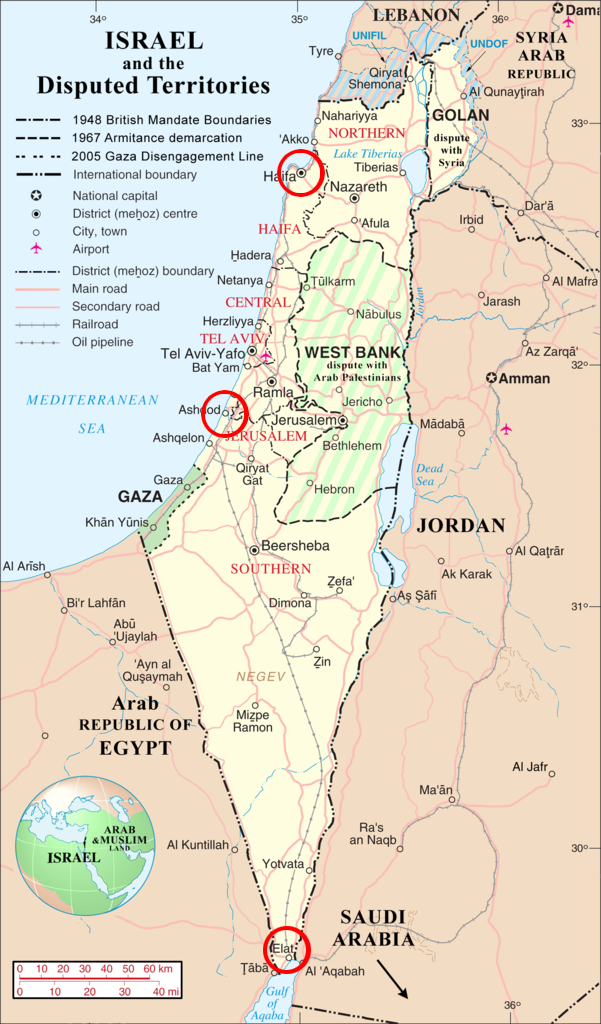
After a long period of exile (the diaspora), the Jews gradually returned to their historic lands, described by the Bible as “Palestine”, but which in the meantime was inhabited and cultivated by local Muslim populations. The inevitable happened, a “return” that others see as an occupation. The problem could have been simple if there was no possibility at first sight to properly coexist an Israeli state, endowed with the best lands in the west, and shreds of scattered territories for a “Muslim Palestine” pushed towards the desert and the Jordanian border. Palestine was for a long time a province of the Ottoman Empire. The latter collapsed ater WW1 and the allies received a “mandate” under the terms of the Picot-Sykes agreement. Old territories helf by the Ottoman Turks according to their influence, such as Syria and Lebanon were allocated to the French, while Palestine and a large portion of territory including current Jordan were attributed to British supervision.
The latter welcomed waves of persecuted Eastern European Jews in the interwar, and immigration that began already in 1880 with early settlers coming to develop desolate lands. This rebirth of the area west of the Jordan was accompanied by a disappearance of malaria and the drying up of marshes, the creation of many agricultural properties which attracted a large Arab labor force. In 1923, however, Great Britain decided to separate Palestine into two districts of unequal importance (using Jordan border river as a frontier).
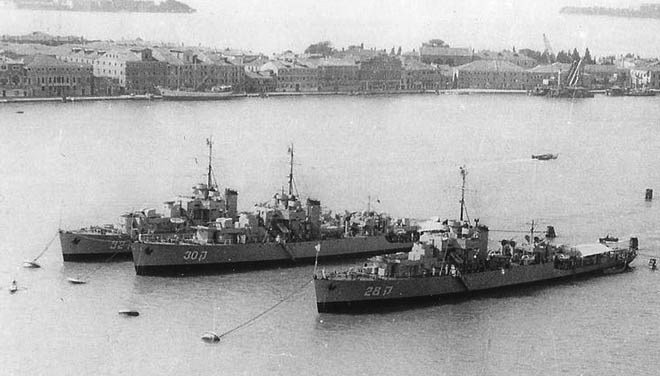
Israeli Frigates in Venice, 1954.
Territories to the east became trans-Jordan, populated by Muslims, and Western Palestine was inhabited mainly by Jews. A movement of Arab nationalists began to take hold and extremism increased. Attacks to drive Jews west of the Jordan River multiplied. They culminated in the Hebron massacres of 1929 and the “great Arab revolt” in 1936-39, which the British failed to contain. The British military presence, however, was firmly maintained in the face of growing opposition from the Jews themselves, in order to keep hold of oil wells recently discovered in Trans-Jordan. Jewish nationalists in turn multiplied attacks in order to obtain independence and the constitution of a Jewish state in Palestine.
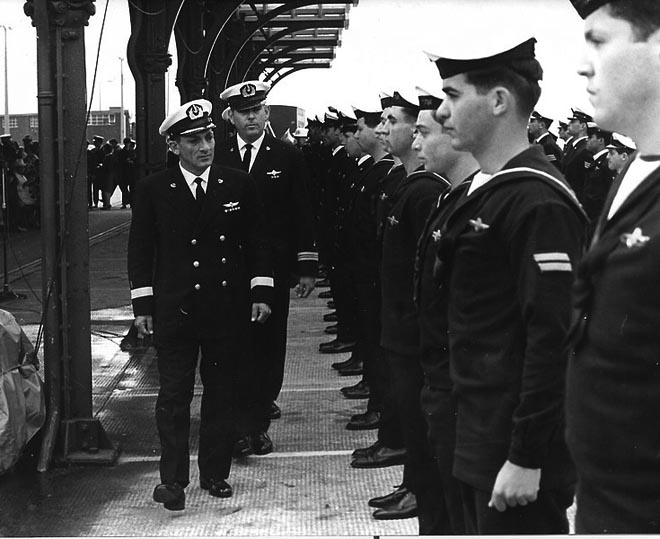
Crew’s review of INS Leviathan in 1967, after commission in portsmouth. Most officers were veterans of the Royal Navy in WW2.
From 1939, however, attention was focused in Europe. The whole continent quickly passed under the Nazi boot and with it, industrial-scale persecution against Jews over the continent, culminating in the Holocaust. After the fall of the Third Reich and the liberation of concentration camps, surviving Jews had only one obsession: Leaving Europe, part of which fell into the Soviet orbit, to take refuge either in the United States or in the “promised land” then in the process of legalization, Israel. “Palestine” was however still administered by British authorities when the first massive waves of immigrants arrived from Europe (Ashkenazim).
The British suffered increasingly bold attacks from the Irgun, led by its charismatic leader Menachem Begin, less to force the British to withdraw and recognize the sovereignty of an Israeli state, than pressed to face more effectively Arab attacks. In 1947 it was finally done. The United Nations in resolution 181 authorized the creation of the state of Israel, but also that of three independent territories, mostly populated by Arabs. For their part, the recently independent Arab nations claimed Palestine as a soverign state and milited for the expulsion of Jews and the extension of Jordan to the coast. The roots of evil were planted for many more wars and a state that was literally built to survive. The Israeli navy was therefore born in the furnace of wartime.
Creation of the Israeli Navy
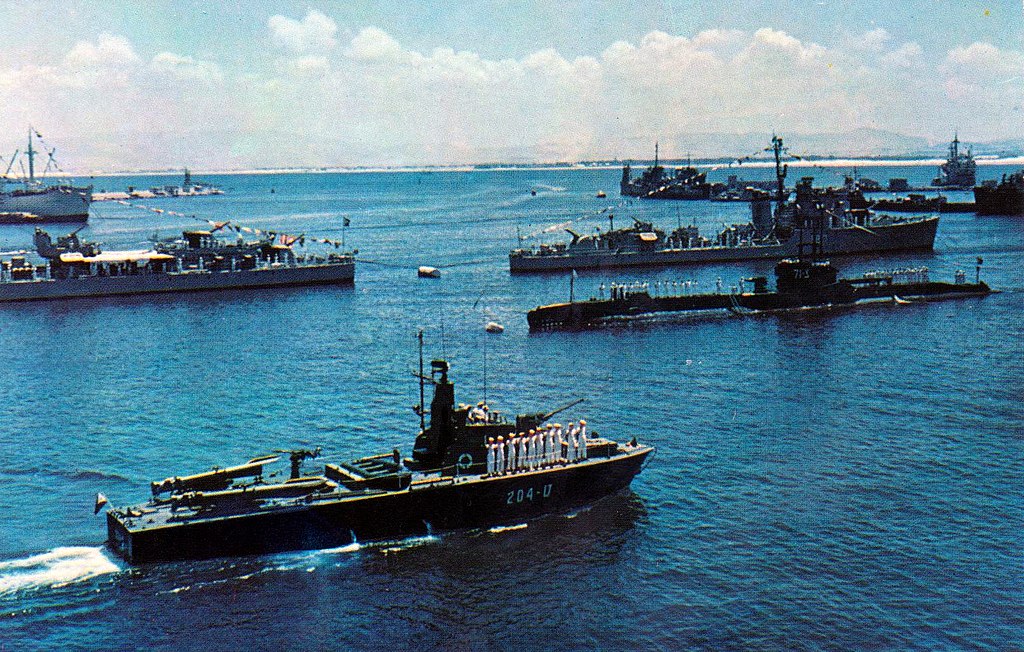
IDF Naval review of 1959 in Haifa.
The state of Israel’s early existence was punctuated by several wars waged by its neighbors: the 1948, 1956, 1967, 1968, and 1973 wars, and Lebanon conflict in the 1980s. Currently IDF possesses certainly one the most modern and capable fleet in the Middle East, but not the largest in terms of raw tonnage, far from it. This coastal force based in Haifa and Ashdod, is also capable of operating in the Red Sea, from Eilat. The navy involvement in various operations is described in the next chapter. This embryonic force formed in 1948 was then composed of a single ex-US coastguard, the USS Northland, which became Eilat. 350 men were on board, most, veterans of the Second World War aboard Royal Navy ships. Some motors torpedo boats inherited from the local Royal Navy also added to this core. Frogmen signed the destruction in 1948 of the Egyptian warship El Amir Farouk off Gaza. In 1956, however, the Israeli navy became significantly larger with the acquisition of two Z class ships in 1955, relatively recent (10 years), three “River” class frigates and two “Flower” class corvettes in 1950 plus an escort destroyer of the “Hunt” class in 1956. But the latter was acquired during the war of 1956 (the campaign of Sinai), while the two newly acquired destroyers allowed to capture in a spectacular way the Egyptian frigate Ibrahim el Awal.
Post-1956 dramatic extension of the fleet
After this campaign, Israel also acquired the first two of modernized English submersibles of the S type (Tanin class) in 1958, and three of the T type (Leviathan class) in 1967-68, operational at the time of the Six Day War. After this conflict, the Israeli Navy in the seventies acquired many other well-adapted ships: Large missile fast attack crafts of the “SAAR” type, German designed (Lürssen) but built in France, 12 SAAR-1s in 1967-69, then the 11 SAAR-4 (or Reshef) in 1973-78, and finally the 5 SAAR-4.5 which were by tonnage and capabilities quasi-corvettes, carrying an helicopter in 1980 and 1990. The spearhead of the current Israeli fleet (post-cold war) consists of the ultra-modern Eilat-class stealth corvettes built in the USA. Israel has also gradually acquired amphibious ships over time: First the three LST Etzion Geber in 1965, then the three LCT of the Ashdod class in 1967, and finally the large Bat Sheva in 1968, ex-South African ship, which added and replaced the existing fleet of ww2-era landing ships and crafts of the LCT, LCI, LCM, or LCM(6) and even a former WW2 German MFP type.
Geographical situation
The IDF Navy is a small, but powerful forcen, spread among three widely separated operationsal bases at Haifa (the main base), while the majority of units and certainly the most modern missile boats are situated at Ashdod (established May 1967) and the Red Sea port of Eilat, while the taken Sharm el Sheikh was returned to Egypt m April 1982. Iarael has a vital strategic location within the boundary of two important seas, the Mediterranenean and the Red Sea. She is surrounded by largely hostile neighbours and faces continuing intirnal disruption coming from the unresolved Palestinian problem. The Naval peace treaty signed with Egypt at Camp David, USA. was of great importance to Israel’s industrial and military needs, among other things making it possible for more ships to safely pass through the Suez canal, the Mediterranean to the Red Sea in two to three days instead of sailing around Africa.
THE ARAB-ISRAELI WARS 1948-82
The navy has ahway been the Cinderella nf the Taraeh Defence Forces. In the 1948 49 War of Indipendence it consisted of about 350kailors with RN andi illegal inmigrant bot experience. Their flagship was the 2150k ex LS Coast Guard nutter Northland, renamed Elath. They also had a few motor boats and naval frogmen, who sank the Egyptian sloop Amir Farouk off Gaza. In 1956, the spectacular capture of the Egyptian frigate Ibrahim al Arwal off Haifa was done by itw twop newly acquired destroyers but well helped by the Israeli air force, and the same Israeli destroyers started shore bembardment of Rafah the next day. Howerer it was no belp to the Army. Before the 1967 Six Day War, the navy had added submarines and eight home-built landing craft to the inventory plus three destroyers, eight MTB and an ASW ship, but Israel’s lightning victory left the
fleet little to do. Three torpedo fast attack craft reached Sharm el Sheik from Eilat to find the Egyptian blockade had evaded. Naval frogmen also performd well in the port of Alexandria and Port Said, achieving a psychological boost. The 1967-70 war of attrition gave more scope to the navy, showing their vulnerabiliry to modem missiles as dramatically shown by the sinking of Eilat.
IDF Intel was less surprised than most by the 1973 war and events went to vindicate the fleet’s new emphasis on eletronic warfare and missiles. 13 FACs defeated 27 arab ones, Komar and osa fitted with longer range Styx missiles. 200 miles off Latakia by night this unique naval battle between FACs when five Israeli units fought the first missile versus missile surtace ation in naval history. They evaded two Styx salvoes of six missiles each, shooting down one with 76mm gun while a Gabriel salvo hit all three Syrin ships. Twe blew up and the third was finished off with 40mm fire. Twe nights later, six Israelli FACs dodged four Styx. Twelve missiles were launched. They destroyed three out of four Egyptian Osa boats off Dumieta, the thirt vessel again being sunk by gunfire. Another twenty-eight Arab missiles, fired in later actions all missed. The Gabriel Mk I missile was shown 85% effective. The relatively protracted Yom Kappur operations allowed the navy to come into its own.
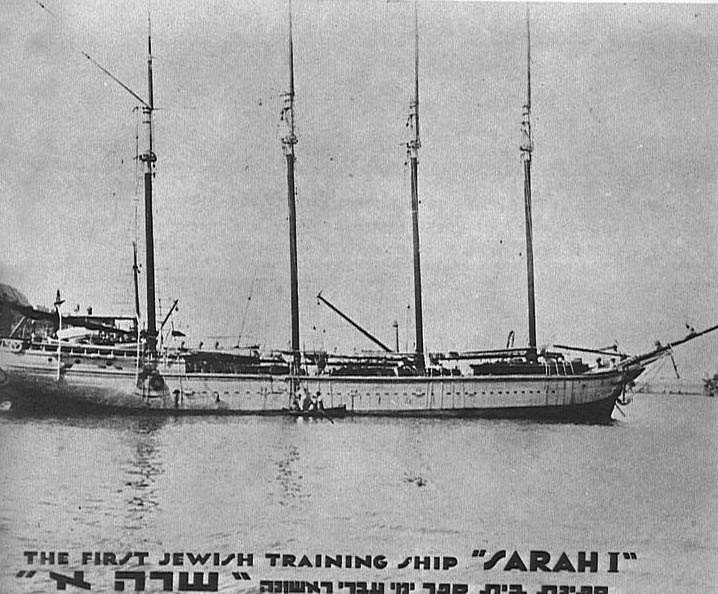
INS Sarah, a 5 masts schooner training ship, first of the IDF.
Constant sorties tied down an armoured frigate on the Syrian coast. The Egyptians, whose Suez Canal crossing stunned the world, failed entirely off Sinai and in the Gulf of Suez, in one typical action, five patrol boats sank nineteen armed fishing boats in the Ras Ghareb unchorage. For a loss of three killed and twenty four wounded, the navy sank nineteen Anab regular warhips. In the course of the war, coastal defence tactics were used and fast attack craft instead of escort shps wore employed. The enemy was generally attacked in his own bases, rarely on the open sea. The Israeli deployed their FACs together with helicopters providing mid-flight guidancs for the missides and decoys for enemy’s own. Such deployment was a novely at the time, and gave excellent results. IDF naval operatione in the 1980s showed a daring only made possible by total air supremacy. In June 1981, FACs hit the PFLF HQ Tripoli in Letari.
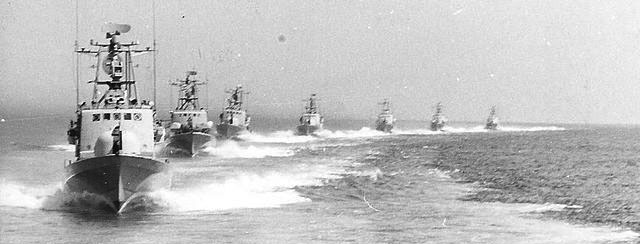
Saar 1 class ships in parade, 1980s
A year later the navy made the maximum effort in amphibious and gunfire support of the army coastal thrust that reached Beirut within four days. The Palestinian military evacuation to Cyprus was effectively regulated by Israel’s warships patrolling off the Lebanese capital. Already in possession of the best trained and equipped fast attack craft group in the Mediterranean, Israel formed a second such unit for deployment on the Red Sea during the 1980s. The rapid build-up of the Libyan Navy prompted the Isracli Navy to order a new type of fast attack corvette with good seakeeping qualities and designed purely for attack. In her present economic situation Israel cannot afford to build a defensive navy and so her requirements are for attack craft, such as missie armed hydrofoils and small guided-missile patrol boats. To counter infiltration by PLO terrorist groups along the 150-mile coastline there are many coastal radar surveillance stations, and patrols by Dabur’ and ‘Yatush’ class craft. These radars and patrols also provide early warning of low-level aerial attacks coming in over the sea.
Israeli Aircraft Industries (IAI) is also involved in the development and production of military equipment for the navy. There are even some small warships built by IAI such as fast attack craft of the “Dabur’ or Dvora’ (missile) classes. During the 1980s the Israeli Navy commissioned only a small number of new warships such as ‘Saar 4.5′ class boats and three missile hydrofoils of the US Flagstaff 2′ class. However, during this time ambitious submarine and corvette plans both received the go-ahead. Two new ocean-going diesel-electric submarines of the “Dolphin’ class were ordered while three ‘Eilat’ class corvettes of very advanced design are being built in the USA. These ships, called by their builders ‘pocket cruisers’, will extend Israel’s maritime reach significantly. There are also plans to acquire six fast attack craft (gun) and two LCTS.
Training
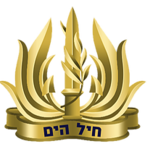 The navy’s high quality personel is its greatest asset, as it was understood also in the context of tanks, leading to the development of the Merkava. There is an israeli electronics school training boys for the two years first round starting at sixteen and leading to national service afterwards. More than 3500 conscripts on 6600 sailors, plus senior officers and petty officers complete the yearly draft for the Navy. The service is over a three year period also, so reservists got a lot of experience.
The navy’s high quality personel is its greatest asset, as it was understood also in the context of tanks, leading to the development of the Merkava. There is an israeli electronics school training boys for the two years first round starting at sixteen and leading to national service afterwards. More than 3500 conscripts on 6600 sailors, plus senior officers and petty officers complete the yearly draft for the Navy. The service is over a three year period also, so reservists got a lot of experience.
Naval commando and frogman training is done by 750 men, women take on many shore jobs and there are about 4000 reserves who do up to up to sixty days annual training. Command is vested in a rear-admiral or commodore. In 1995, total naval personal ammounted to 7,000 comprsing also 700 officers, over three years of service.
Missiles of the IDFN
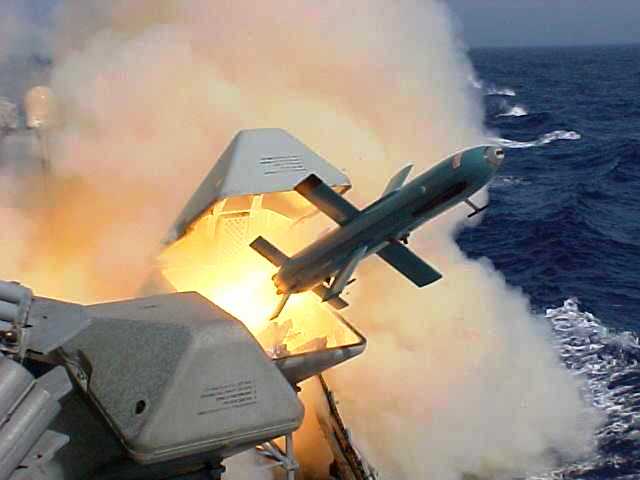
Gabriel missile just out, fired
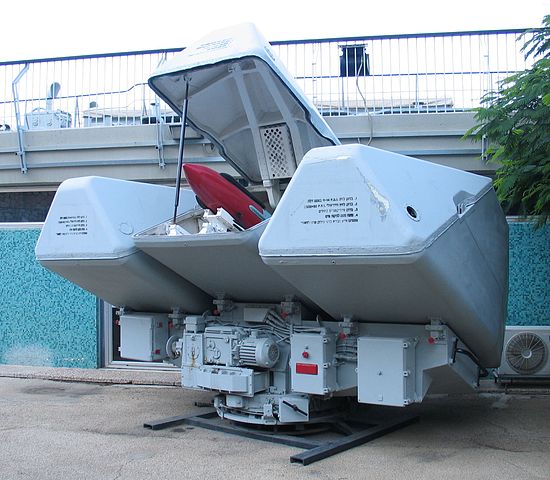
Gabriel launch canister
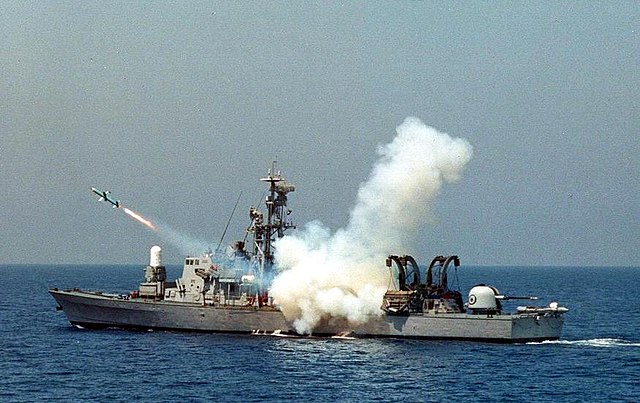
SAAR 4 firing
The IAI Gabriel was a 3.35-3.78 m long 430-560 kgs missile with a mimimal flight altitude of 2.5 m (8 ft 2 in), using a guidance with Semi-Active Radar for the two early Marks and Active Radar on the three later Marks. It carried a waread from 100 kg (220 lb) to 150 kg and eventually 240 kg (530 lb) from 20 on the early mark to 6–36 km (3.7–22.4 mi), 36 km (22 mi), 60 km (37 mi), 200 km (120 mi) on the Mark IV and for the Mark V/Blue Spear/Sea Serpent up to 400 km (250 mi).
The 1973 war boosted its sales internationally. It was (or still is) used by Azerbaijan, Chile, Ecuador, Eritrea, Estonia, Finland, Kenya, Mexico, Sri Lanka, India, Argentina, Singapore, South Africa, Taiwan, Thailand and Brazil.
Surface-to-surface Gabriel type guided missiles designed and produced in Israel are well-known internationally. There are two versions, Mk I and Mk 2, and the much improved Gabriel Mk 3 entering service in 1995. Gabriel Mk I carried out trials in the late 1950s and during the early 1960s it was decided to adopt the concept of the missile armed fast attack crafft as the main unit for future deployment with the Israeli Navy.
The Israeli Navy’s concept of the missile gun armed FPB to replace the destroyer and frigate was vindicated by the success of the Gabriel Mk 1 in the 1973 Yom Kippur War, despite its disadvantages such as limited range (20km) due to the solid fuel rocket motor and target handling (resulting from the semi-active homing system which permits only one target to be selected for engagement). During the early 1970s the Gabriel Mk 2 carried increased fuel of a more modern type, which extended its range to 36km. The range was in fact greater than 36km but the effective range was limited by the extent of coverage of the search and fire control radars then operational.
The Gabriel Mk 2 still has the semi-active homing missile, IAI has therefore developed the Gabriel Mk 3 missile, which uses a fully active homing head, enabling the operator to fire the missile and forget it, In fact the Mk 3 missile can operate in three modes: fire and forget (possible to engage four targets simultaneously); fire and update – the missile’s computer is updated while in flight to assimilate a target’s changing parameters, which enables the homing seeker in the head to be activated at the latest possible moment to overcome ECM; and fire and control incorporates the capability of the Mk 1 and Mk 2 missiles to control the missile throughout the whole of its flight and thus to concentrate on one target alone.
The latest concept in missile tactics to gain favour is that of the Cocktail’, designed to overcome and confuse ECM systems: different types of missiles are fired at the target simultaneously and it is possible that a Mk 2 and Mk 3 Gabriel might be fired simultaneously using different modes of attack, Furthermore it is to be noted that the Reshef class are now equipped with the US Harpoon missile so providing even greater possibilities for Cocktail’ mixes. Work on the proposed Gabriel Mk 4 anti-ship swept-wing missile has been abandoned. It was to have weighed is 960kg (150-200kg warhead) with a speed of Mach 0.85. Reportedly up to the present 2500-3000 Gabriels in all versions have been manufactured. It is interesting to note the current cost of one Gabriel missile: Mk 1/2- $400,000, Mk 3-$450,000, Mk 3 A/S $550,000, These costs have risen dramatically since 1971, when a Gabriel Mk 1 SSM cost only S85,000-$95,000. The Gabriel Mk 2 is being manufactured in South Africa under licence, while the was developed. In recent years Israeli industry has also produced a surface-to-air VLS. The missile weighs 98kg, is fitted with a warhead of 22kg and entering Israeli service in 1991-92. It was exported to Chile in 1988 and also armed the new “Victory-class” Singaporean frigates.
Artillery of the IDF Navy
In addition to developing missile tech, IAI deveoped a new twin 30 mm for point defence called TCM 30. It used the Hispano-Suiza 931 model, and the mount was low on a relatively heavy structure supporting the muzzles and designed to overcome muzzle droop and vibrations leading to little dispersion, an essential feature in a gun anti-missile system. The fully automated system is a completely above deck system with a magazine of 150 rounds per gun fired in bursts of 5, 10, 15 or 20 rounds. Target speeds up to 250-300m/sec can be handled and the barrels have an elevation of -50 to +85°. The mount has undergone satisfactory trials
in a Reshef class ship and was expected to equip the Reshef class and vessels then under construction, with subsequently a possible retrofitted for the older ‘Saar’ class boats. In the end it was fitted only to the
Shimrit class hydrofoils. In practice the Israeli Navy adopted mostly foreign systems. All bigger fighting ships are equipped with US Vulcan Phalanx Mk 15 CIWS and OTO Melara automatic 76mm/62 guns. Phalanx CIWSE pianned to be replaced with Barak SAM, The new corvettes will receive the new American Sea Vulcan 25 mm close-in weapon system.–>
The 1970s, in search of military independence
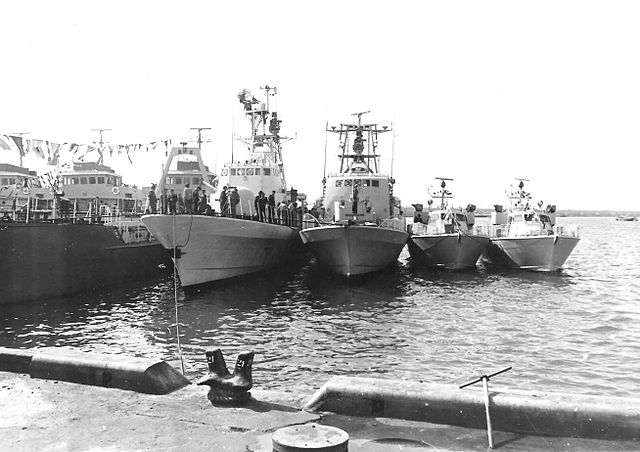
INS Ahsdod LCT, Saar 2, Saar 4, and Dabur in 1978
The Israeli created their own defense industries, notably because of the French arms embargo before the beginning of the Six-Day War, and IAI (Israeli Aircraft Industry) designed and built the Dvora FACs in 1977, considered in its day as one of the very best of this light type in the world. It was derived from the 1973 Dabur by then equipped only with cannons. This prototype was followed by the “Super Dvora” series, from 1987 (4 in sevice 1990). In addition, hydrofoils were considered as an interesting alternative to traditional FACs and could be used as sea interceptors. Three units were built in the USA on the model of the USS Flagstaff in 1982-85, called the Shimrit class. These forces were complemented by Kedma class patrol boats (1968), preceded by the Yar 2 in 1956, and the Ophir class (3) and Ayah class (6) motor torpedo boats, which were added to the existing three British MTBs in 1949, one of type Fairmile B in 1950 (Haportzim), and three HDML, named the Dror, Saar, and Tirtsa. Israel also replaced its five ex-British submarines with German designed, but Vickers-build units modified type 206, called Gal class, in 1975-76. More recently, a new class of submarines was ordered on the same principle (to be built in Ingalls, UK), and derived based on the German type 212, but finally built in Kiel in 1997, the Dolphin class.
Below are following the known and listed strength of the Israeli Navy at the eve of the Six Day War, Yom Kippur, and the Gulf War.
Fleet strength in 1967:
-Two destroyers, Eilat and Yaffa, the DE Haifa, the three submersible Leviathan class and the two Tanin class, the 6 VLT Ayah class, the 3 Ophir class, the 2 Yar class patrol boats, 2 HDML, the three LCT Etzion Geber.
Fleet Strength in 1973:
-Two submarines, Dolphin and Leviathan, 12 SAAR-1 missile launchers (Mirtach), 3 Ophir VLT class, 2 Yar, 4 Kedma class, 2 HDML, 3 LST class Etzion Geber, 3 class Ashdod, 1 Bat Sheva.
Fleet strength for 1990:
-3 Gal class subs., 12 class SAAR-1, 11 class SAAR-4, 4 class SAAR-4.5, 1 Dvora, 4 Super-Dvora FACs, 3 Shimrit class hydrofoil FACs, 24 Dabur class patrol boats, 28 Yatush, 4 Kedma, 3 Geber class LSTs, 3 Ashdod class LCTs, 1 Bat Sheva LST.
Israeli Navy Bases and Organization
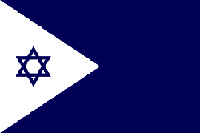 Patrol squadrons comprises the Squadrons 914, 915, and 916, based in Haifa, Eilat, and Ashdod, to protect shores and territorial waters (patrol boats squadrons: Dvora, Shaldag ect).
Patrol squadrons comprises the Squadrons 914, 915, and 916, based in Haifa, Eilat, and Ashdod, to protect shores and territorial waters (patrol boats squadrons: Dvora, Shaldag ect).
-3rd Flotilla is equipped with missile boat flotilla (Shayetet 3), based at Haifa. 31st and 32nd missile boat sqn (Saar 4-4.5 boats), 33rd and 36th corvette squadrons. They are assigned traditional tasks of protecting Israeli commerce, prevent a naval blockade in wartime, blockade ports themselves and well as fire support for ground units.
-7th Flotilla is the main submarine flotilla (Shayetet 7) and volunteer unit founded in 1959. Its main objective is Attacking enemy vessels, trade lines and assets in distant waters. Like other subs, Covert intelligence gathering are secondary and deployment and recovery of Shayetet 13 naval commandos, third mission. Although classified, porobable nuclear weapons capability, so deterrence and second strike missions.
–Shayetet 13 (Flotilla 13) elite naval commando same missions as most special forces.
–Salvage and underwater works unit: Damage control branch attached to Navy Shipyards, with Flotilla-13 divers.
–Snapir: Force protection and harbour security unit (uses Defender boats), diving checkups of civilian ships entering Israeli harbours as well for security.
–IDFN Intel division: HQ for Naval intelligence gathering.
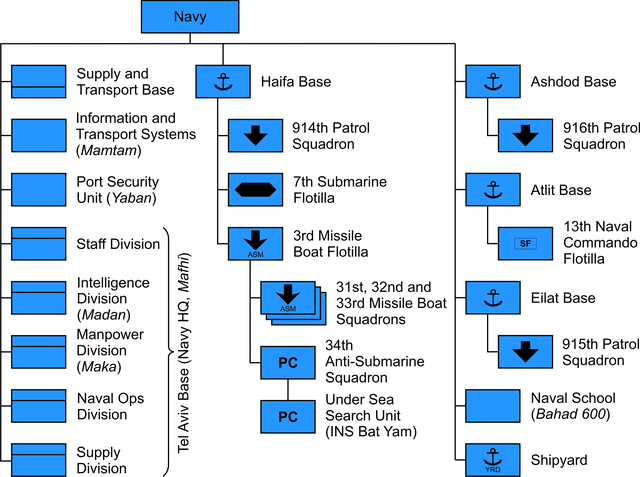
Bases
IDF Navy Headquarter: HaKirya, Tel Aviv.
Haifa: Home of Shayetet 3 Missile Boats Flotilla, Submarine Flotilla and Patrol Boats Squadron 914.
Haifa Naval Training base: submarine operations school, the missile boat operations school and the naval command school. The naval training base also functions as the Israeli Naval Academy.
Atlit: Home to Shayetet 13, elite commando unit.
Ashdod: Home of Patrol Boats Squadron 916.
Eilat: Home of Patrol Boats Squadron 915. Founded 1951, Red Sea theater since 1981
Mamtam: IT, processing and computing HQ, unit responsible for all Israeli Navy signal and IT systems with programmers and university graduates in engineering and computer science
The Israeli Navy in Operations
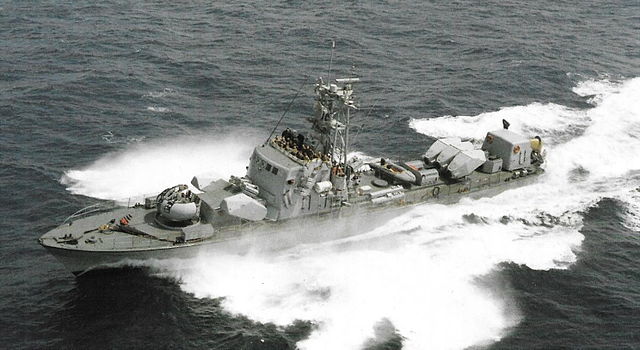
1956, capture of INS Haifa
In 1948, the “fleet” only by name, did not have the least impact in the operations. In 1956, the Suez crisis in which the French, British and IDF were invlved in, a feat caused a sensation: The Egyptian frigate Ibrahim el Awal was captured by IDF forces, already been fired upon by the French destroyer Cassard following her night raid and shelling of Haifa installations. Rockets from two Sud-Est Ouragan jets recently purchased from the French stopped the frigate. After capture, she was evacuated and towed to Haifa before being pressed into Isreali service under that same name, “Haifa”, becoming the first major vessel of the embryonic navy.
1967 six-day war:
During the 6-day war, the speed of the Israeli offensive left little time for the navy to shine. However, during the ensuing period, Eilat attacked and destroyed along with two MTBs, two other Egyptian ships on the coast of Sinai. In retaliation, the egytians sent recent Komar-class FACs, wich sank INS Eilat off Port Said. The latter did not even left the port and the three SSN-3 Styx hit her at anchor.
1973 Yom Kippour war:
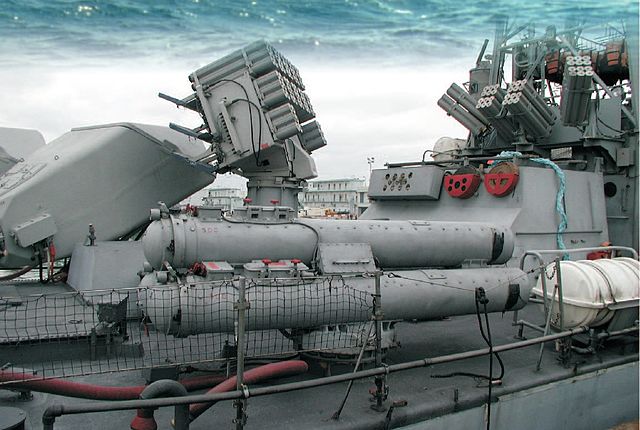
ASW TTs, Chaff launchers and Gabriel SSM canister on the crowded deck of a SAAR 4 vessel
The Israeli forces also adopted a locally-designed state-of-the-art guidance equipment and developed the IAI Gabriel missiles. In 1973, at Yom Kippur, 13 IDF FACs equipped with 63 IAI “Gabriel” anti-ship missiles routed a force of 27 Syrian and Egyptian Komar and Osa FACs, armed with a total of 84 Styx missiles. This was the first example of a missile FAC battle in history. The famous Gabriel demonstrated an efficiency at least as great as the French Exocet, as exposed later in the Falklands. Israeli reputation in these advanced weapons system, battle-proven, benefited exports greatly after this action. Many Soviet “Styx” missiles were also shot down in mid-flight by QF cannons and effective countermeasures, showing once a missile was in the air, a FAC was not defenseless. Other actions were successfully carried out by smaller units, such as patrol boats. Thus, in the Gulf of Suez, 5 fast patrol boats were sent by bottom in a few minutes and no less than 19 trawlers and Egyptian armed patrol boats in the harbor of Ras Galeb went donw as well. Operations followed one another, notably using helicopter guidance, tracking and countermeasures combined with missile launcher launches, a veritable naval “blitzkrieg”, which all proved to be valuable for coastal operations, in foreign navies.
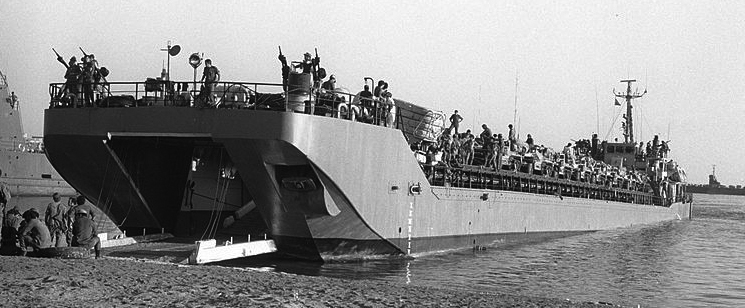
Bat Sheva LST
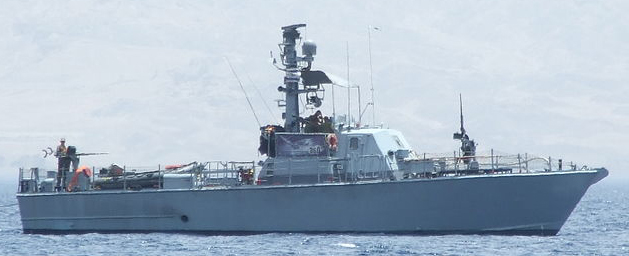
Dabur class FACs
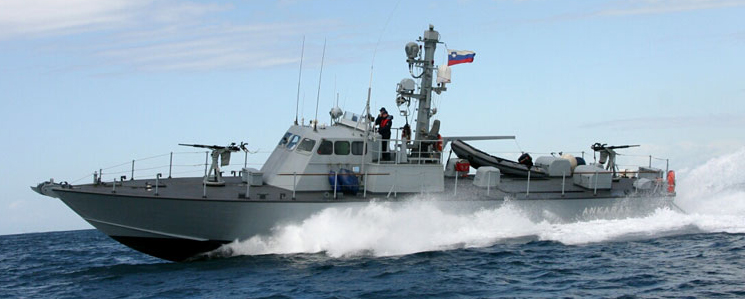
HPL-21 Ankaran, export version of the Super-Dvora class FACs
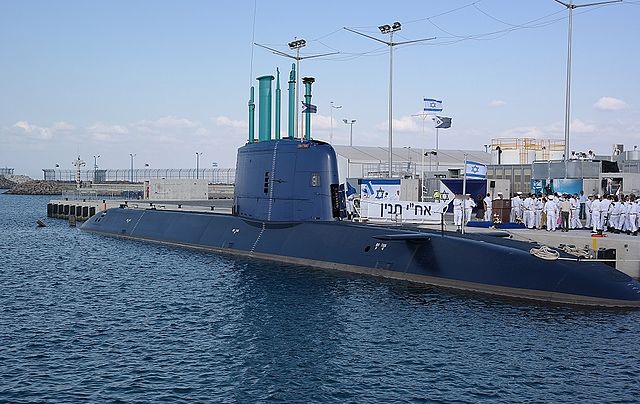
INS Tanin, Dolphin 2 class Attack Submarines
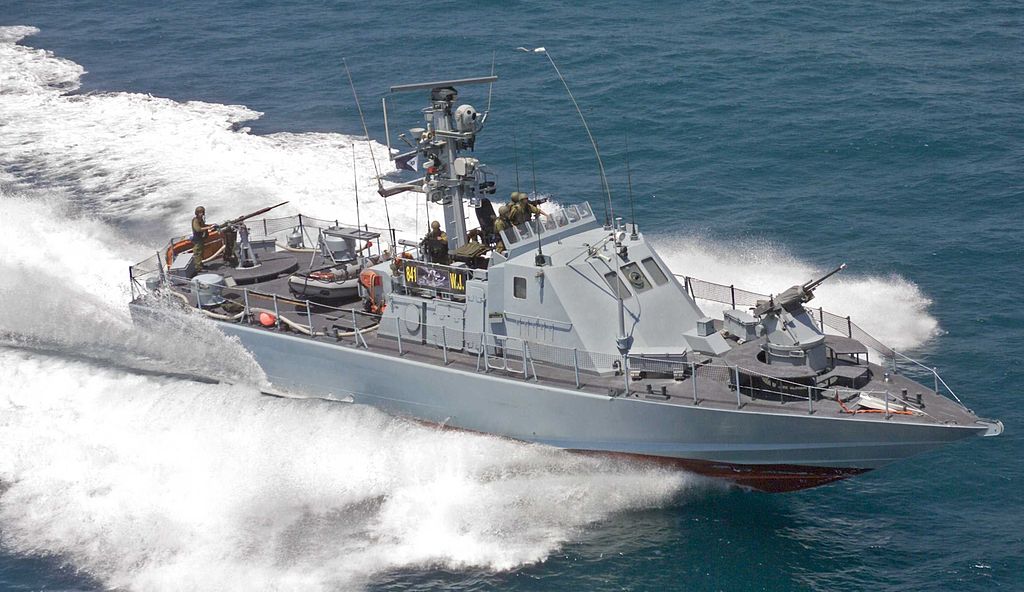
Shaldag Mk.3 class Fast Patrol Crafts
Lebanon crisis 1981
During the Lebanon war in 1981, an Israeli SAAR hit and destroyed the PFLP headquarters in Tripoli. Priority was also given to means of support during landings in Beirut. Since then, the role of patrol boats has been mainly to control any infiltration of PLO agents into Israeli territory.
The rise of the Libyan fleet forced the General Staff to rethink its construction program and to consider larger ships than the FACs deployed so far: It was initially the big SAAR 4.5 capable of operating and housing an helicopter, and more recently with the lessons of the 1991 Gulf War, and the Iraqi threat (which passed an order of 4 frigates and 6 corvettes to Italy shortly before invading Kuwait), acquired three stealth High-tech corvettes of the Eilat class and ordered in the US a tailor-built weapons sytem inspired by the Aegis system, but in reduction.
These are nowadays in effect some of the most capable ships in the Middle East. And they have already their nose blooded: INS Hanit (“blade”) was damaged by a C-802 ASM fired by Hezbollah during the 2006 Lebanon War, but was fully Repaired.
IDF Navy strenght as of 2024
7 corvettes: Sa’ar 5 class: INS Eilat, Lahav, Hanit. Sa’ar 6 class: INS Magen, Oz, Atzmaut, Nitzachon
8 missile boats – Sa’ar 4.5 class: INS Romach, Keshet, Hetz, Kidon, Tarshish, Yaffo, Herev, Sufa
5 submarines – Dolphin/Dolphin 2 class: INS Dolphin, Livyathan, Tekumah, Tanin, Rahav, Drakon
45 patrol boats: 9 Dvora class, 2 Super Dvora II class, 13 Super Dvora III, 5 Shaldag, 9 Defender +UAVs in development
2 support ships.
Personal: 9,500 active and 10,000 reservists (partly mobilized after the 2023 Hamas attacks)
 Eilat (SAAR 5) class Corvettes (1993)
Eilat (SAAR 5) class Corvettes (1993)

Stealthy Corvettes class SAAR5 (Eilat) in formation, pride of the current Israeli navy.
Only mentioned there as they were planned in 1989. The Israeli naval staff obtained that the government ordered four Sa’ar 6-class corvettes, of German-Israeli design, and built in Germany. They proceed from a much earlier prospect as the French already in 1982 proposed a design, which was never accepted or ordered. The new design came after a long reflection and rewrite of specifications. It is loosely based on the Braunschweig-class corvette with a reinforced baseline platform to carry and operate more scalable military hardware on the long term. ThyssenKrupp Marine Systems participated in the design, and the first of these ships (yet unnamed) is scheduled to enter service in 2019. Actual status in completion.
Cost is estimated 1.8 billion Israeli new shekel (NIS) or 430-million Euro ($480-million), German Government subsidizing a third of the construction costs, as well as the Dolphin class submarines. They are tasked to protect natural gas platforms in the Mediterranean sea, threatened by the Lebanese Hezbollah group as sitting in Palestinian waters.
These SAAR 6 are 2,000 tons, 90 m (300 ft) long vessels armed with an Melara 76 mm main gun, two Typhoon weapon systems, 32 vertical launch cells for Barak-8 surface-to-air missiles, C-Dome point defense system, 16 anti-ship missiles and two 324 mm torpedo launchers and EL/M-2248 MF-STAR AESA radar plus hangar to accommodate an SH-60 ASW helicopter. A pretty decent firepower for such a small package.
 Atzmaut (SAAR 6) class Corvettes (2020)
Atzmaut (SAAR 6) class Corvettes (2020)
INS Magen, Oz, Atzmaut, Nitzachon
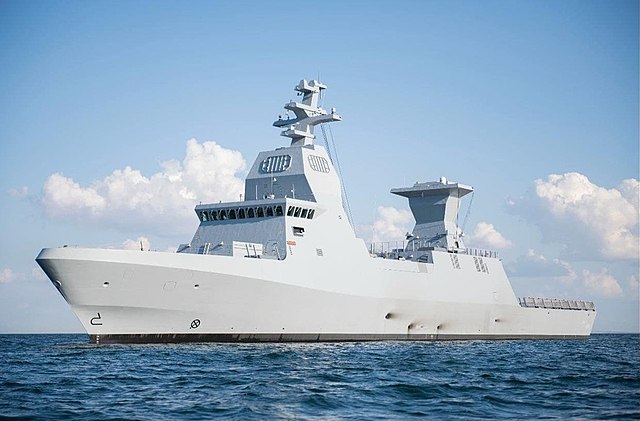
Tne very latest Sa’ar class evolution, and true sized corvettes, just like the Sa’ar 5. Again, stealthy state of the art missile ships, certainly among the most capable corvettes in the world, making the IDF a serious eastern Mediterranean regional naval power, with Egypt as traditional enemy. German influence was there in the design as many experts saw them as loosely inspired by German Braunschweig-class with Israeli-built sensors and missiles, double innovation with the Barak 8/naval Iron Dome system and new Elbit Systems EW.
All four vessels were constructed in Germany (joint project by German Naval Yards Holdings + TKMS). First delivered in 2020 at NIS 1.8 billion (430 million Euros/$480 million), partly subzidized by the German Government as with the Dolphin-class submarines. The irony is they are more heavily armed than the Brauschweig class and it can be assumed they also act as a testbed for up-arming the latter in case of war.
Names are INS Magen (Shield), Oz (Courage), Atzmaut (Independence) and Nitzachon (Victory), first laid down in February 2018, last being commissioned recently in December 2023. They are expected to sail about 2,000 sea hours a year, for about 30 years.
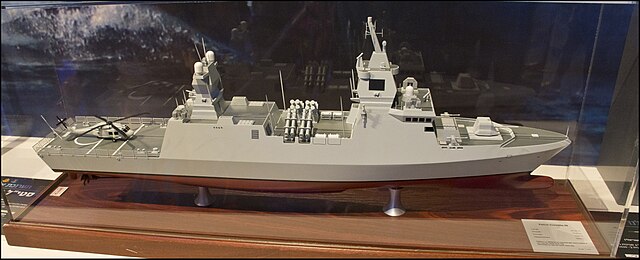
Specifications
Displacement: 1,900 long tons (1,900 t) full load
Dimensions: 90 m (295 ft 3 in), width 13,28 m (), draught 3.4 m ()
Powerplant: Four MTU 16V 4000 M93L diesels 3,440 kW each, CODAD
Top speed: c30 kts
Range: 4,000 nmi (7,408 km; 4,600 mi)
Crew: 65 core crew members, 10 air crew
Sensors: EL/M-2248 MF-STAR AESA radar, C-GEM RF Active Decoy
Armament: Oto Melara 76 mm gun, 2× Typhoon RWS, VLSx16 Barak-8, VLSx40 C-Dome PDS, VLSx16 Gabriel V/Harpoon Block II, 2× 324 mm ASWTTs, MH-60 Seahawk helicopter
 Dolphin 1 class subs (1998)
Dolphin 1 class subs (1998)
INS Dolphin, Leviathan, Tekuma
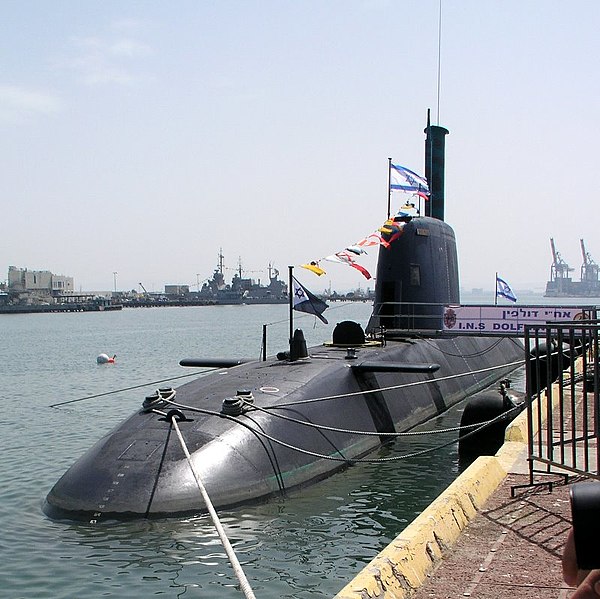
INS Dolphin
Modified Type 212 submarines built in Howaldtswerke, Kiel + Thyssen. The class comprised INS Dolphin, Leviathan and Tekuma. IKL Type 800 replacing the Type 500 submarines, authorized in 1988 but project cancelled in 1990. They wete originally to be assembled in Ingalls, Pascagoula using prefabricated sections by HDW but in January 1991 the German government offered to built the first two submarines in Germany, with German combat systems. In 1995 the third ordered was reinstated. They were given swimmer lockout facilities in the sail and boat stowage for eight spec-ops.
Torpedo tubes were placed in two horizontal rows, the 650mm tubes outboard. One is usabled for swimmer exit and ingress. Liners are used for torpedo launching and they are enabled the Turbo Popeye nuclear cruise missile, and Triton anti-helicopter missile. Still in service today, alongside the 2012-2020 built Tanin class, built in HDW, Kiel, Germany + Nordseewerke. The latter are also called “Dolphin 2 class”, ordered 2006 and 2012, enlarged and upgraded, but tailored to use Israeli missiles and combat control system. The Israeli fleet as for today thanks to its six Type 212s is probably one of the best in the region.
 Dolphin 2 class subs (2012)
Dolphin 2 class subs (2012)
Tanin, Lahav, Drakon

Essentially an AIP (Air Independent Propulsion) stretched version of the Dolphin I. hey are the largest subs built in Germany since World War II, most expensive “vehicles” in IDF service ever, replacing the Gal class. Still armed with 16 torpedoes, “Popeye” Turbo submarine-launched cruise missiles (SLCMs) ranged 1,500 km (930 mi) and alternatively which can be fitted with a conventional or 200 kt nuclear warhead as rumored, giving the IDF a deterrence capability, and offshore nuclear “second-strike” capability.
Nice cutaway illustration by HI Sutton
Three more, Dakar class: In October 2017, Israel and Germany confirmed MoU covering a purchase of three more Dolphin-class, FY 2027. Deal was formally signed in January 2022 with a schedule of delivery within nine years to replace the Dolphin I. Germany will provide industrial subsidies again to cover 1/3 of the cost. See the Dakar class below.
Specifications:
Displacement: 2,050 tons surfaced, 2,400 tons submerged
Dimensions: 68.6 x 6.8 x 6.2m (225 x 22 x 20 ft)
Propulsion: Air-independent HDW Fuel Cell System, 25 knots
Test depth: At least 350 m (1,150 ft)
Complement: 35 + 10 additional
Sensors: STN Atlas ISUS 90-55 combat system
Armament: 6 × 533 mm (21.0 in) TTs, 4 × 650 mm (26 in) TTs
Replacement for the Dolphin 1: Dakar-class submarines, FY2027, first in service 2031, enlarged AIP.
 Dakar class subs (2030s)
Dakar class subs (2030s)
No picture as yet.
The Dakar-class submarine as agreed with Germany, will also be AIP-capable diesel-electric and t be built at ThyssenKrupp Marine Systems (TKMS). They are a likely larger design compared to the Dolphin 2 (c3000 tons+), customized to carry out more operational requirements and the lead boat was named after INS Dakar, which mysteriously sank in 1968.
In January 2022, the MoD confirmed they will replace the Dolphin I class from 2031 onwards.
Specs:
74 m (243 ft) estimated in overall lenght, displacement above 3000/3500 tonnes submerged, Diesel-electric propulsion with AIP, armed with torpedoes and AShM, potential nuclear cap. May incorporate VLS as well.
Enlarged sail with possible airlock for spec ops, UUV/UAV hangar, better C&C for ISR capabilities, even possibly SLBM.
Same “X-shaped” rudder configuration but no smaller horizontal and vertical stabilizers and silent prop screw modelled after 218SG/Type 216 concept.
 Defender class (2002)
Defender class (2002)
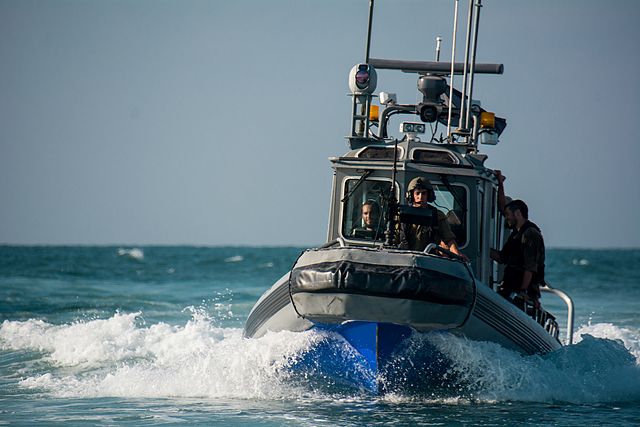
The Defender-class boas, also called Response Boat–Small (RB-S) and Response Boat–Homeland Security (RB-HS) were made for the United States Coast Guard in 2002, used for SAR, port security, law enforcement duties and in the case of the IDF, arms smuggling prevention and anti-terrorist activities. US built with an aluminium hull despite their appareance (still inflated), they wree built by SAFE Boats International in the US and laterly exported abroad. Nine are used by the IDF Maritime Police, as there is no IDF coast guard.
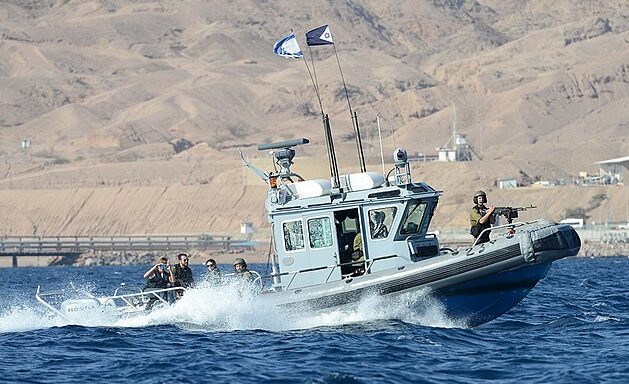
Specs
8.5 long tons (8.6 t), 8.9/9 x 2.6 x 0.98 m (29 ft 6 in x 8 ft 6 in x 3 ft 3 in)
Propulsion: 2 × Honda 4-stroke outboard engines, 225 hp (168 kW) each, 46 knots. RA 150 nmi (280 km; 170 mi)
Crew: 4 crew, 6 passengers. Navigation radar with GPS
Armament: 1–2 × M240B and/or M2HB
 IDF UAVs (2020s)
IDF UAVs (2020s)
Two classes
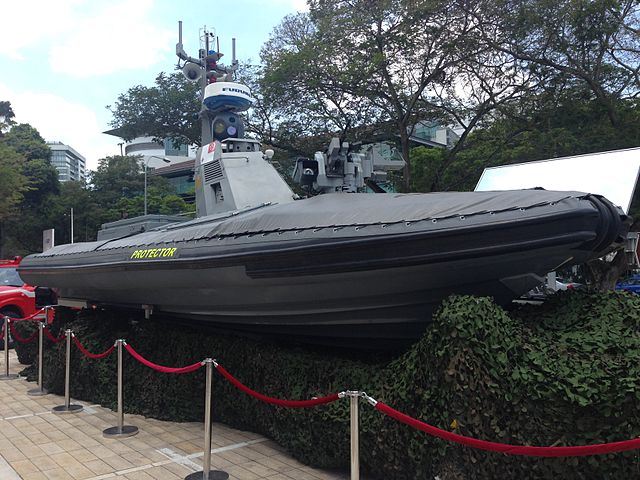
Two models: The Rafael Protector USV and the Silver Marlin.
The Protector unmanned surface vehicle (USV) developed by Israeli Rafael Advanced Defense Systems was made to deal with terrorist threats against maritime assets (USS Cole bombing) and became the world’s first operational combat USV in service. It had a small variant of the Typhoon Weapon Station. In 2005, Singapore Navy was ther first to adopt and deploy these in the Persian Gulf, it also patrolled for anti-piracy duties in the Gulf of Aden. In 2012, Rafael announced a stretched, 11 metre version with greater range and more weaponry. Numbers in IDF service are classified. Actual negociation and joint tests with BAE and the USN could lead to an adoption both by UK and the US.
Specs:
4 tonnes, 9 x 3.5 x 0.45 m (29 ft 6.3 in), Diesel Water jet 50 knots RA 400 nm@30 Knots
The Silver Marlin is a Rigid hull inflatable boat USVs equipped with a 7.62mm RWS, observation satcom, endurance of 24–36 hours, and was fielded for reconnaissance, surveillance, force protection/anti-terror, anti-surface and anti-mine warfare, as well as SAR port and waterway patrol, even battle damage assessment and pollution detection and treatment, even electronic warfare. Numbers in service with the IDF is unknown, but dates back 2006.
Specs: 10.67 m (35.0 ft) long, 4,000 kg (8,800 lb), 2,500 kg (5,500 lb) payload, 2x 315 hp diesel engines 45 kts, 500 nm
Read More/Src
idf.il
IDF subs portal
On imra.org
On navypedia
About the Doplhin class subs
Official site
timesofisrael.com/topic/israeli-navy/
IDF navy vets
On Hazegray
About Mahal volunteers
On IDF navy vets
jewishvirtuallibrary.org – About volunteers
IDF Navy against Hezbollah
IDF Navy insigna ranks
Janes: Dome air defence system
defense-update.com: reshef class
israel-germany-seal-offshore-patrol-vessel-deal
israeldefense.co.il
On globalsecurity.org
about the no dual citizen policy in subs
Battle of Latakia
The boats of Cherbourg
On Ashe Lincoln
List of Israeli Ships – Early cold war
Ships deployed (and for some lost) during the wars of 1956, 1967 and 1973:
 Eilat class destroyers (1955)
Eilat class destroyers (1955)
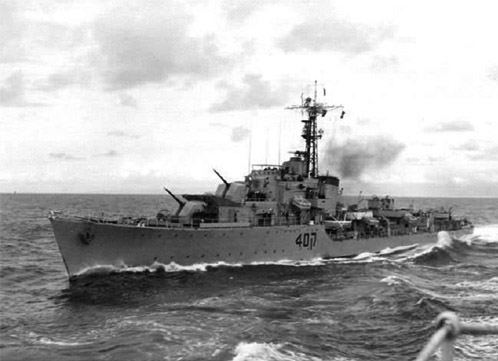
INS Eilat at sea
Eilat, Yaffo
In 1955 the UK sold HMS Zealous and Zodiac, active from November 1944 to Israel, commissioned as INS Eilat (From the eponym city) and Yaffo (same), in July 1956. On 31 October 1956 (the Suez Crisis) the Egyptian destroyer Ibrahim el Awal, a former Hunt class destroyer shelled the port of Haifa and was counter-attacked by the French destroyer Kersaint and both Israeli destroyers, Yaffo and Eilat. Together, they forced the Egyptian destroyer back towards Port Said when she was also attacked by two IDF/AF Ouragans, and a Douglas Dakota. The crew capitulated, the ship was boarded, and towed to Haifa (and renamed Haifa) to be recommissioned in Israeli service (see later).

The ex-British Destroyer Eilat in the 1960s, an ex-1944 Z class destroyer HMS Zealous (R39) acquired in 1955, sunk by Egyptian Komar class FAC (Missiles) on 21 October 1967. It was a world’s first in naval history…
Both destroyers, not modified since 1956, also soldiered on in 1967:
During a night patrol on 11–12 July 1967, Eilat and two Israeli MTBs met two Egyptian MTBs off the Rumani coast, engaged and sank them, but INS Eilat herself was sunk on 21 October 1967 in Mediterranean international waters, off Port Said (Sinai) hit by three Styx missiles from Egyptian Komar type FACs. This was a world’s first, whhich immediately attracted attention on missile FACs. Eilat’s radar was able to spot the vessels but could not recougnise their type, and the latter were soon in range to fire, from within the port, which blurred the signal. Eilat’s captain ordered an evasive action when all four vectors were detected, but there was a first hit above the waterline, and a second not far away.
Eilat listed heavily, but there was no rescue to come. She remained dead in the water until a second missile wave, six strong, hit her, also from Port Said. The third missile hit Eilat amidships, but a fourth went astray, crashing in the water. Burning and listing, she sank two minutes later, with 47 killed/missing, 90–100 wounded. 67 hours after the attack Port Suez was shelled, its three oil refineries destroyed and areas as well despite UN requests for a ceasefire. Only Soviet Union dispatching seven warships dissuaded Israel from further attacks. This event also had a profond impact on the IDF Navy, spawning greater interest for missile FACs, which caracterized the navy ever since. The end result was the successful use of Sa’ar 2-class in the Yom Kippur War. On her side, INS Yaffo was stricken in 1972, so one year before this war.
 Frigate INS Haifa (1956)
Frigate INS Haifa (1956)
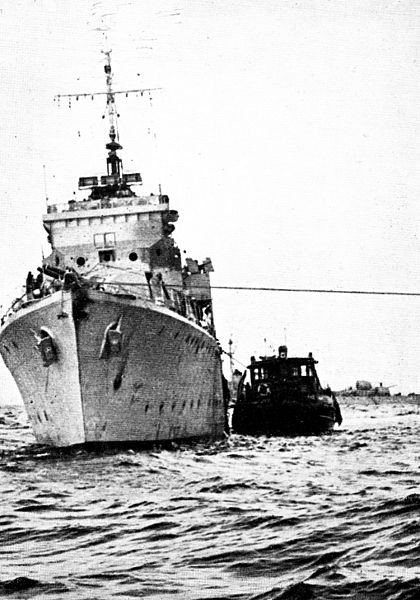
Ibrahim el-Awal taken in tow by Israeli tugs in October 1956
Some WW2 ships had amazing careers. Such was the case with HMS Mendip, a Hunt type 1 escort destroyer (launched 1940), soldiering in WW2, she was resold as Lin Fu and recommissioned on 21 January 1948 under ROC service until the Nationalist fell and took refuge in Taiwan at the end of the civil war. Out of service on 29 May 1949 she was returned to the RN. In November 1949, she was resold to the Egyptian navy, recommissioned as Mohammed Ali el-Kebi (15 November 1949) and renamed again Ibrahim el-Awal in 1951. In 1956 she took part in the Suez crisis, dispatched on 30 October 1956 to Haifa, in order to shell the city’s coastal oil installations. French and Israeli ships deployed during Operation Musketeer chased her off back to port Said, but she was caught and hammered by Ouragan fighters until surrendering to approaching IDF vessels, her turbo generator destroyed and rudder jammed. The crew attemped to scuttled her but cold not due to rusted valves. They just surrendered when IDF ships arrived. She was towed to the port of Haifa after capture, incorporated into the Israeli Navy as INS Haifa. She served until the late 1960s and decommissioned,, relegated as target ship and sunk in 1970 by a Gabriel missile, IDF answer to the Soviet Styx.
 Mivtakh class frigates (1950)
Mivtakh class frigates (1950)
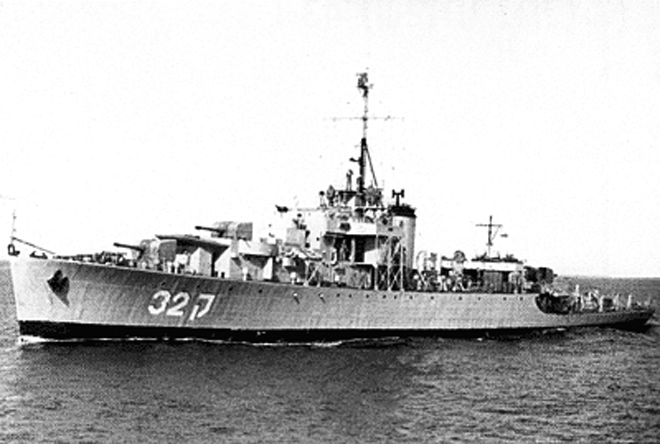
INS Miznak 1950s
Mivtakh, Misnak, Misgav
Three Canadian Yarrow-built River class Frigates purchased in 1950. They had been resold to merchant service in 1945-47 and later acquired on the stocks and renamed Mivtakh, Misnak and Misgav. No modifications apart an additional 4-in gun mounted on Misgav in 1956 during the Suez crisis, in which all three took a part. Some has been resold to Egypt as well and met their equivalent both in the IDF but also Royal Navies… The first two were resold in August 1959 and the last to the Royal Ceylon Navy, stricken in 1961. Their pennants were 28, 32 and 30.
 Hagahah class corvettes (1950)
Hagahah class corvettes (1950)
Wedgewood, Haganah
Two ex-RCN flower class, Canadian-built (Morton yard) corvettes, resold to merchant service and acquired on the stocks in 1950. HMCS Beauharnois and Norsyd became Wedgewood and Haganah respectively (no pennant). Both served until 1956, stricken, taking no part to the Suez crisis.
 Tanin class subs (1958)
Tanin class subs (1958)
INS Tanin, Lahav
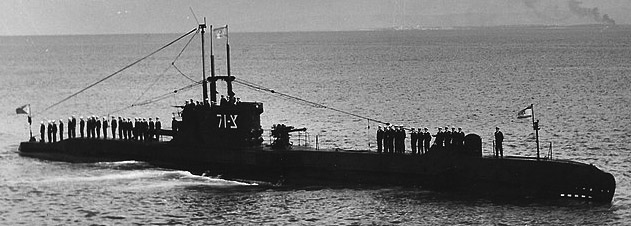
INS Tanin 1971
Tanin, Rahav
Ex British-built S-class submersibles from the wartime series, HMS Springer and Sanguine buult in Cammell Laird, launched in 1945. They had little service in WW2, and were soon placed on the disposal list, pending a possible purchase. It came in October 1958 as both were ordered by the Israeli Navy. They were modernized as part of the purchased before delivery. The first was renamed Tanin (#71) in December 1959 as commissioned and the second Rahav (#72) in May 1960. Already capable of a crash dive in 30 sec. they were fitted with “snort” mast and sonar domes. INS Tanin participated in the Six-Day War, carrying and launching naval commandos (frogmen) to attack the port of Alexandria. They tried to torpedo an Egyptian sloop (damaged) but did not returned. Tanin’s Commander, Lieutenant Commander Abraham (Ivan) Dror (later Rear Admiral) received the Israeli citation for valour as a result of his actions at the port of Alexandria. INS Rahav participated in six days war. Worn out, she could not submerge and was stricken after being used asn ASW warfare training sub. Tanin was stricken in 1968 to be cannibalized and maintain Rahav. She was officially stricken in 1972.
 Leviathan class Subs (1967)
Leviathan class Subs (1967)
Leviathan, Dakar, Dolphin
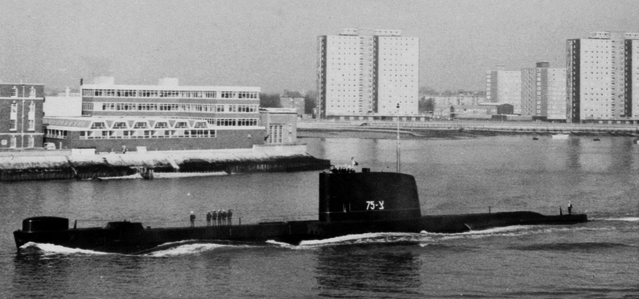
INS Leviathan leaving Portsmouth 1967
Three oceanic T-class submersibles built at Chatham and Devonport in 1944-45. Their acquisition by IDF was announced in 1964, and they were modernized before transfer, in May and November 1967 and January 1968, too late to take part in the six-day 1967 war. The modernization of HMS Turpin (INS Leviathan, #75) had her streamlined and lenghtened by 12 feets, Totem (INS Dakar #77) and Truncheon (INS Dolphin #78) by 20 feets. Guns and external TTs were removed, electronics and sonars modernized. Dakar was lost during her transfer in the eastern Mediterranean in January 1968. Leviathan was discarded in 1975 and Dolphin in 1977 so both wre active during the Yom Kippur war.
 Gal class Subs (1976)
Gal class Subs (1976)
Gal, Tanin, Rahav

INS Gal, German-designed, British built modified Type 206 diesel submarine
The Israeli Gal class submarines were based on a modified German HDW Type 206 submarine class (Type 540), with significant difference to make it a class of itw own, as they were built in Britain, not in Germany and took part in the Lebanon crisis notably, now retired. INS Gal was startred in 1974, launched on 2 December 1975 and completed in June 1976, decommissioned in 2000 and now a museum ship since 2007. INS Tanin (ex-Gur) was launched on 25 October 1976 and completed on lst June 1977. She was decommissioned two years later in 2002 and scrapped. INS Rahav was launched on 8 May 1977 and completed on 18 December 1977, but the first decommissioned, in 1997 for reasons seen later. They replaced themselves older WW2 vessels (modernized).

Specs:
Displacement: 420 tonnes Surfaced, 600 tonnes Submerged
Dimensions: 45 x 4.7 x 3.7 m (148 x 15 x 12 ft)
Propulsion: 2 × MTU diesels 1200 hp & AEG Generators, one electric motor 1800 hp
Speed: 11 knots Surfaced, 17 kn (31 km/h; 20 mph) Submerged
Crew: 32
Sensors: radar Plessey, Sonar Plessey classified Electronic warfare
Armament: 8 × 533mm Tubes bow, Sub-Harpoon Missiles, NT 37E torpedoes, optional MANPAD
 SAAR 1 class FACs (1967)
SAAR 1 class FACs (1967)
Mirtak, Miznag, Mufgav, Eilath, Haifa, Akko, Saar, Hanit, Gaash, Herev, Hanit, Hetz
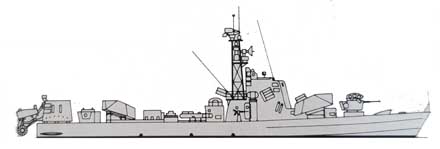
INS Yaffo as completed, 1973
The Sa’ar class were designed in Germany by Lürssen and built in france at CMN Cherbourg. The first six were ordered in 1965 fitted at first with three 40 mm Breda guns like the Italian Freccia PBs, and classified as “SAAR 1” class while the second serie was ordered in 1966, also six ships with a 76 mm OTO Melara gun. The first three plus Haifa were delivered unarmed so to circumvent the embargo and the last five were “stolen” in Cherbourg on 24 November 1969, officially registered as “Starboatd I-V” supply ship for the Norwegian oilfield refinery at sea and under Panamean flag. They all made it in Israel and were officially commissioned in 1970 (launched 1967-69).
Two more were delivered after the embargo was lifted.
The class was modified and later sub-distinguished as SAAR 2 and SAAR 3 boats. The SAAR I had three 40 mm/70 Modello 1958/11 Breda guns, four single 324 mm Mk.32 ASW TTs with Mk.46 acoustic torpedoes and two 0.5 in cal. HMGs and an ELAC sonar. The SAAR 2 boats had an interim 76 mm OTO gun. SAAR 3 subgroup had Gabriel SSMs fitted, making them missile FACs. More on the Gabriel SSMs soon. Electronics were French & Italian. They were in the 1970s the most sophisticated Israeli vessels so far and the most powerful regional warships afloat. In 1973 (Yom Kippur) they showed their metal by sinking seven Arab FACs without any loss in October. They were discarded gradually in the 1990s, with Hanit and Hetze resold to Chile.
⚙ Specs Saar 3 |
|
| Dimensions | 44,9 m (146 ft) x Beam 7 m (23 ft) x Draught 1.7-2.5 m (6-8 ft) |
| Displacement | 220 long tons standard, 250 long tons FL |
| Propulsion | 4 shaft maybach Mercedes MD872 diesels 13,500 shp |
| Speed | 42 knots () |
| Range | 1000-2500 nmi at 30-15 knots |
| Electronics | Thomson CSF Neptune, Selenia Orion, ECM VHF DIF, intercept gear |
| Armament | 2×3 Gabriel SSMs, 1x 76 mm OTO, 12 Chaff RL |
| Crew | 35-40 |
 SAAR 4 class FACs (1973)
SAAR 4 class FACs (1973)

INS Yaffo as completed, 1973
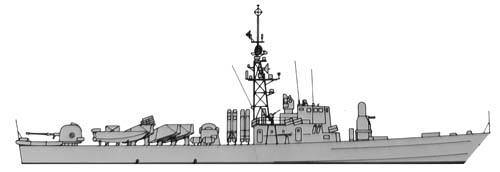
INS Modelet as modernized, 1987
Reshef, Keshet, Romah, Kidon, Tarshish, Yaffo, Nitzahon, Atsmout, Modelet, Komemiut.
Development of new long range FACs started in 1968, and designed for an increase in armament and electronics, to reach the level of a small corvette. The largest upgrade was the obtention of Harpoon SSMs added to the already capability of the Gabriels for shorter range. Their were much larger, with a displacement beyond 400 tonnes, more range, to the price of less speed. With missiles indeed, reaching 42 knots seems no longer necessary. Missiles had a sufficient reach to reach targets sufficiently far away, and for the Harpoons, beyond the horizon. They were fitted all with two OTO Melara guns (fore and aft) but modernized versions had a Phalanx CIWS forward (Modelet, Komemiut) and powerful ECM capabilities as well as a generous Chaff launching system (four large, six small, all 12-barrelled) to make them invulnerable to missiles of the generation still used by arab countries in the 1970s. Ten ships were built in total in two batches, launched 1973-79. Also for the first time, all the electronics were Israeli made.
In total Thirteen were built at the Israel Shipyards, ten for the Israeli Navy and three for the South African Navy plus another six built in South Africa with Israeli assistance. Very capable ships, they missed the Yom Kippur war but participated in operations off the Lebanese coast, notably enforcing the blocus and fighting Hezbollah fast boats. Keshet and Romash were resold in 1979-80 to Chile, followed by Reshef in 1997 as well as Tarshish. INS Kidon was preserved as submarine memorials and Yaffo scrapped in 1998. All last four ships were redirected to ASW warfare and their systems recycles into the Sa’ar 4.5 hulls. The last two were sold to Sri Lanka in 2000 and sold for BU recently. The Chilean vessels are still in service, but one is used for spares. The SANDF Warrior-class (Minister class) strike craft has been all decommissioned before 2021.
⚙ Specs Saar 4 |
|
| Dimensions | 58,1 m (190 ft) x Beam 7.6 m (24 ft) x Draught 2.4 m (7 ft) |
| Displacement | 415 long tons standard, 450 long tons FL |
| Propulsion | 4 shaft MTU 16V diesels 14,000 shp |
| Speed | 32 knots |
| Range | 4000/1600 nmi at 17-30 knots |
| Electronics | Thomson CSF Neptune, Selenia Orion, ECM MN56 intercept, Chaff RL |
| Armament | 2×4 Harpoon SSM, 6 Gabriel SSMs, 2×76 mm OTO, 2×20 mm, AA 12 Chaff RL |
| Crew | 45-50 |
 Dvora class FAC(M)s (1976)
Dvora class FAC(M)s (1976)
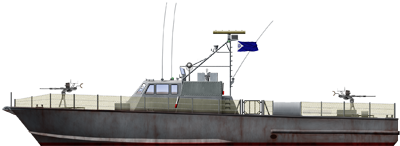
Naval Encylopedia’s rendition of the INS Dvora class
A single prototype was made, similar to the “Dabur” but smaller, nimbler and faster, and still designed to carry missiles. The Dvora (“seagull”) became the smallest missile FAC on the market, and in fact, was designed for practicity and tailored for the export market. It was constructed of aluminium alloys, was transportable by land, and also stored on land with ease, and modular. Trials started in 1977, and right away two were ordered by Nicaragua at 3-4 million $ apiece, basically 15% cheaper than standard FACs, even Soviet.
The IDF ordered for the Israeli Sea Corps nine, and Initially 11 were in service wth the prototype stricken in 1991, decommissioned after collision with a rocky shoal. It was a smash on the export market, with four ordered for the Sri Lanka Navy, acquired in 1984-1986, some sunk in the 1990s, and the Republic of China Navy: Two original Dvora acquired in the 1980s plus 48 local variants called Hai Ou-class retired 1999-2012 and 6 gifted to Gambia and Paraguay.
⚙ Specs Dvora 1977 |
|
| Dimensions | 21,6 m (70 ft) x Beam 5.5 m (18 ft) x Draught 0.9 m (6 ft) |
| Displacement | 38 long tons standard, 47 long tons FL |
| Propulsion | 2 shafts MTU 12V diesels 2,720 shp |
| Speed | 36 knots |
| Range | 700 nmi at 27-32 knots |
| Electronics | Radar DECCA 926 |
| Armament | 2 Gabriel SSMs, 2x 20 mm, 2x 12.7 mm HMG |
| Crew | 10 |
 Lilitt class MTBs (1949)
Lilitt class MTBs (1949)
Three and up to nine (according to various sources) British-built 70 feets Vosper Motor Torpedo Boats (MTB) were purchased in 1948-49. They were as registered in the 1950s INS Lilitt (pennant 209), Shaldagg (210) and Tinshemett (212). Specs as the original MTBs, but possible electronic modernization in the late 1950s. In any case, their fate is uncertain but they were no longer registered in 1967 and did not took part in operations, but probably patrolled Israeli waters during the 1956 Suez crisis.
Israeli Motor Launches (1952-53)
In 1951 or 52, the Israeli Navy also acquired an ex-Fairmile B type motor launch, ex M-17, renamed Haportzim, armed with three 20 mm Oerlikon guns and twelve DCs. She was stricken in 1961. At the same tme were also obtained three habour defence motor launches, renamed Dvor, Saar and Tirsta, pennants 21, 35 and 25 respectively. They were rearmed with a single 40 mm Bofors, one 20 mm and 8 DCs and after Saar was discarded in 1965 or 1968 the others were rearmed one 47 mm, one 40 mm Bofors and 8 DCs or two 20 mm guns, and were kept for police work and coast guard until stricken in 1974-1976.
M17, a Fairmile B motor launch purchased in the 1950s, renamed “Haportzim”, was armed with three 20 mm Oerlikon and 12 DCs. She was stricken in 1961.
HDML Dvor, Saar and Tirsa: Three former Harbour Defence Motor Launches (HDML) transferred in the 1950 for coastal patrols. They had a 40 mm Bofors, one 20 mm Oerlikon and eight DCs. Saar was stricken 1965-68, the others were tranbsferred to the coast giard and maritime police, stricken 1974-76.
 Ayah class FAC(T)s (1951)
Ayah class FAC(T)s (1951)
Ayah, Baz, Daya, Peress, Tahmass, Yasoor.
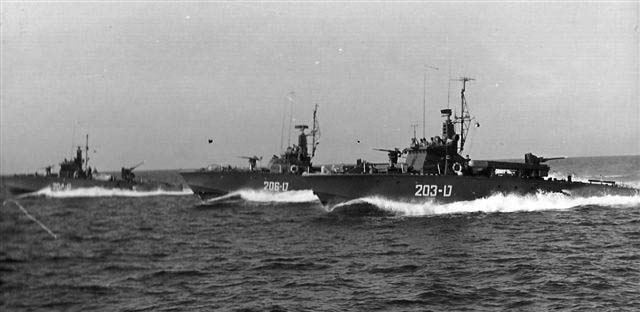
French-built Israeli MTBs from Chantiers Navals de Meulan
Built in France, ordered 1949, delivered 1951-52. They were the first dedicated Fast Attack Crafts of the Israeli Navy, capable of 42 knots and torpedo armed. They orginally had a wooden hull, propelled by four 12-cylinder Arsenal marine/Otto petrol engines producing 4200 bhp total. They were armed originally with one 40 mm Bofors, four 20 mm Oerlikon AA, two 457 mm TTs, but served mostly as MGBs, without their TTs. They were modernized in 1961-62: See specs. The Deltic Diesels improved the range and safety to the cost of some speed, the superstructures were altered, radars added, but in the late 1960s they only retained one or two 20 mm AA and were used as PBs only. Stricken 1972-74.
⚙ Specs Ayah 1962 |
|
| Dimensions | 26 m (85 ft) x Beam 6.3 m (20 ft) x Draught 1.5 m (4 ft) |
| Displacement | 62 long tons standard, 70 long tons FL |
| Propulsion | 2 shafts Deltic diesels 5,000 bhp |
| Speed | 40 knots |
| Range | 600-900 nmi at 25-32 knots |
| Electronics | Radar DECCA 926 |
| Armament | 1x 40 mm, 2x 20 mm, 2x 18-in TTs |
| Crew | 15 |
 Ophir class FAC(T)s(1956)
Ophir class FAC(T)s(1956)
Ophir, Shva, Tarshish.
Built in Baglietto, Italy with the same specs as the French boats, wooden hull and same engines, same armament. Pennants T150-52, delivered 1956-57. Not modernized in the 1960s but radar probably added, TT and the 40 mm removed. Stricken 1970s (No photo or blueprint).
⚙ Specs Ophir 1957 |
|
| Dimensions | 21,3 m (70 ft) x Beam 5.2 m (17 ft) x Draught 1.5 m (5 ft) |
| Displacement | 40 long tons standard, 45 long tons FL |
| Propulsion | 2 shafts petrol Packard-Otto 4,000 bhp |
| Speed | 40 knots |
| Range | 400 nmi at 28 knots |
| Electronics | None as built |
| Armament | 1x 40 mm, 2x 20 mm, 2x 18-in TTs |
| Crew | 14 |
 Yar class OPVs (1956)
Yar class OPVs (1956)
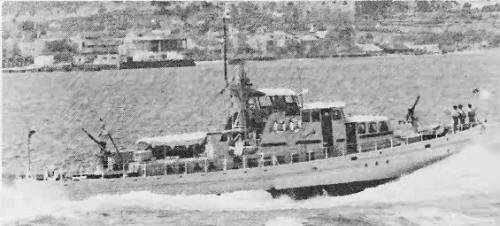
Yarden, Yarkon.
Two coast guard cutters purchased in Germany by Yacht & Bootswerft Burmester of Bremen in 1956, delivered in 1957. They were 25 knots were coast guard cutters relegated as TS in the late 1960s and discarded in 1976 (unknown for Yarden, non-armed training craft).
⚙ Specs Yar 1957 |
|
| Dimensions | 30,5 m (100 ft) x Beam 6.1 m (20 ft) x Draught 1.8 m (6 ft) |
| Displacement | 96 long tons standard, 109 long tons FL |
| Propulsion | 2 shafts MTU 12V diesels 2,000? bhp |
| Speed | 22 knots |
| Range | 900 nmi at 20 knots |
| Armament | 2x 20 mm AA |
| Crew | 16 |
 Kedma class CPCs (1968)
Kedma class CPCs (1968)
Kedma, Yama, Negba, Tzafona.
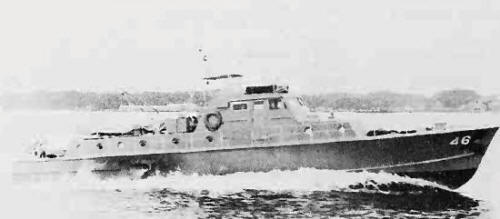
Built in Japan in 1968, handy boats of the small seaward defence type. Stee hull, used for coast guard and police duties along the coast, capable of 25 knots. Their 20 mm were discarded and replaced by light MGs at the end of their career. They were discarded in 1992.
⚙ Specs Kedma 1969 |
|
| Dimensions | 20,4 m (66 ft) x Beam 4.6 m (15 ft) x Draught 1.5 m (4 ft) |
| Displacement | 26 long tons standard, 39 long tons FL |
| Propulsion | 2 shaftsdiesels 1,540 shp |
| Speed | 25 knots |
| Range | 700 nmi at 27-32 knots |
| Armament | 2x 20 mm AA |
| Crew | 10 |
Israeli early assault ships (1950s)
 AFHAL PYAKAN tank landing craft
AFHAL PYAKAN tank landing craft
Afhal Pyakan, Gosh Atzion
Former British TLC(2) type tank landing craft. The first arrived Israel with refugees on board while the second was purchased from the Royal Navy. Discarded in 1957-58.
 IAD MORDEKHAI landing barges
IAD MORDEKHAI landing barges
Iad Mordekhai, Vavid Harvah
These were former German MFP type D barges, transferred from Italy in 1948, used both in the 1948 war and 1956 Suez crisis, discarded in 1957.
 ROMAT RAKHEL infantry landing ships
ROMAT RAKHEL infantry landing ships
Ramat Rachel, Nitzanim
These were WW2 LCI(L) purchased in 1948-49. They served their purpose in 1956 at Suez and were discarded the next year.
 Makh LCM landing craft
Makh LCM landing craft
i-vi, Makh-32, Makh-38, Makh-40
WW2 Landing Crafts, mechanized, nine purchased on the stocks in 1949 and three more built in Israel in 1957-1961. The first were discared probably in 1957 and the latter in the late 1980s.
 SHEVA medium landing ships
SHEVA medium landing ships
Sheva, Ofir, Tarshish
Former USN LSM class medium landing ships, purchased from merchant service in 1970, stricken in 1984.
 Etzion Gueber class assault ships (1965)
Etzion Gueber class assault ships (1965)
Atzion Gueber (F51), Kessari (F53), Shikmona (F55)
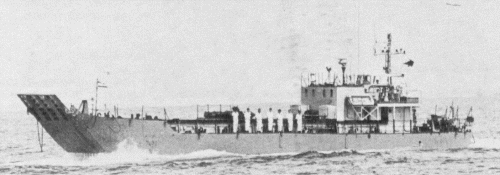
Three landing ship built in Israel, Israel SYds, Haifa in 1964-65. Small LCUs inspired by British WW2 LCU models. They were credited with other dimensions, 36.6 x 7.1 x 1.4 m (120 ft x 23 ft 4 in x 4 ft 7 in). They were all transported by land to Eilat for the six days war and back across the desert by night, to tie down Egyptian ships in the red sea, simulating a buildup for the capture of Sharm El Sheikh, a brillant and successful deception. All three were stricken in 1991.
Quic specs: Displacement 182/230 T FL, Length 27.5/36.6m, beam 7.10, draught 1.40, 2 shafts diesels 1280 bhp 10 kts, armed with two 20mm/70 Mk 10, carrying 3 tanks and about 250 troops. Crew 12.
 Ashdod class LCT (1966)
Ashdod class LCT (1966)
Ashdod (F61), Ashkelon (F63), Achkziv (F65)

Three LCTs built in Haifa Shipyard in 1966-67. Completion during the six days war. An helicopter pad was fitted aft. Ashdod was tested for the Barak VLS from 2002. Ashkelon was sold to Ethiopia in 1993 and Ashkziv was discarded in 1999.

⚙ Specs Ash class 1967 |
|
| Dimensions | 62.7 m (207 ft) x Beam 10 m (32 ft) x Draught 1.8 m (5 ft) |
| Displacement | 400 long tons standard, 730 long tons FL |
| Propulsion | 3 shafts MWM diesels 1,900 bhp |
| Speed | 10.5 knots |
| Range | Oil 37 tons, 500? nmi at 8 knots |
| Armament | 2x 20 mm AA |
| Crew | 20 |
Bat Sheva LCT (1966)

INS Bat Sheva was the ex-Tzilngi, built in the Netherlands for South Africa in 1967, repurchased by Israel as it could not be delivered due to the embargo. She had a bow ramp and was presumably used in Lebanon. She was pprobably discarded in the late 1990s or early 2000s.
Quickspecs: Displacement 900 t stadard, 1150 tons FL. Dimensions 95.1 x 11.2 x 2.1m. Machinery 2×2 Paxman & Iberia diesels, 10 kts. Armed with Four 20mm/70 Mk 10, four 0.5 cal. or 12.7mm/90 HMGs. Military load: 16 tanks, 2 helicopters (Super Frelon), Electronic equipment 2 Decca 926 radars, crew 26.

INS Bat Sheva profile by the author, for Efim Sandler’s book, Helion Publishing
Misc.
–INS Nogah, ex-PC 1188 standard US submarine-chaser was transferred in 1952 or 1953 and clasified as patrol vessel, discarded from 1975 and used as target ship for Gabriel SSMs.
–INS Eilath, the ex USN Northand coast guard cutter WPG49 (1927) acquired in 1948 after brief mercantile service. She rammed a RN destroyer during her migrant run thanks to her reinforced icebreaker bow, and had a 60 mm mountain gun lashed to her deck, so she was quite active in the 1948-49 war as well. She became a training ship, partially disarmed, renamed Matzpen, and sold for BU 1962.
–INS Mala, TS. Ex-Mayflower (1897), used already in the 1898 war, 1902-1905 presidential yacht with the Russo-japanese peace treaty signed on board. Discarded 1929, badly burned in 1931, SS Butte in south Am service, USS WPG 38 (armed transport) from 1942-45, Coast Guard & TS 1946, decomm. burnt, repurchased under Panamean flag in Israeli service and used as migrant runner in 1947, then TS until 1955, BU.
Late cold war IDF ships
These ships took part in the 1980s Lebanon war.
Dabur class CPCs (1973)
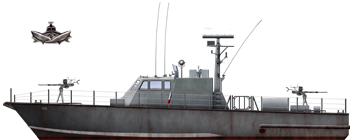
Naval Encylopedia’s rendition of the INS Dabur class
The Dabur class were a 35 tons, 19.80 m (65.0 ft long) aluminum patrol boats initiated by the government aft 1967 to watch over home waters. They were all ordered in the USA to Sewart Seacraft (now Swiftships) shipyard, Morgan City, Louisiana . The first Dabur-class (also known as the IAI-Ramta) was laid down in 1970, 12 completed and 22 more built by IAI-Ramta in Israel for 34 total. They were light vessels that can be carried overland and redployed from the Mediterranean to the Red sea. They possessed rough weather capability but were too slow and soon phased out and replaced.
They had diesel General Motors type 12V71TN rated for 2,400 hp (1,800 kW) on two shafts for 22 knots (41 km/h; 25 mph) up to 18 kn and 540 nmi (1,000 km; 620 mi) at patrol speed armed with just two Oerlikon 20 mm cannons and two 12.7 mm Browning M2HB HMGs, but two 324 mm (13 in) torpedo tubes were also provided for the Mark 46 torpedo and spaced at the stern was prepared to support two racks of depth charges. At some point they had Carl Gustav recoilless rifles mounted for anti-terrorist purposes.
The Dabur-class boats were seen in action during the October 1973 Yom Kippur War when two Dabur boats attacked an Egyptian commando force in Marse Talamat, destroyed their speed boats and rubber dinghies just before operation in the Sinai Peninsula. This raid was made in cooperation with the Mossad, which obtained the information in the first place. Five also were given to Lebanese militias and patrolled Lebanon waters to blockade possible by sea arms supplies to the Hezbollah. Israeli Navy’s Daburs were also deployed along the Lebanon coast for the same reasons.
The five Christian Lebanese Forces Militia boats given in 1976 were returned in 1990. In 1978 four were sold to Argentina, four to Nicaragua. In 1984 two went to Sri Lanka and in 1991 four to Fiji, six to Chile, plus another four in 1995, and Nicaragua three more in 1996.
 Yatush class Patrol Boats (1974)
Yatush class Patrol Boats (1974)
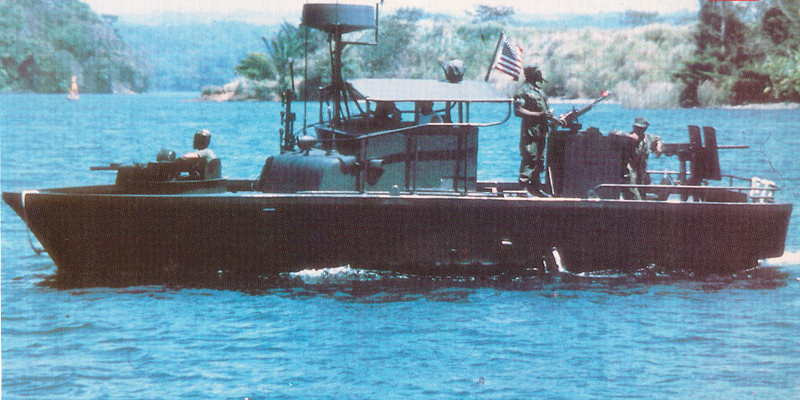
These were ex-USN PBR (The famous Vietnam River boats) 6.5 tones, bought from 1974 on decommissioned stocks and up to 28 were operational for the Lebanon war in 1982 where they took an important role to prevent arms smuggling. Two were later given to the Lebanese Christians in 1975-76, and the armament was stock US, with two or three M60s and/or Browning M1919A4, M2HB 0.5 in, and 60 mm mortar with the last beiong stricken in 1990-91 after quite a long career for these small fiberclass vessels (which were easy to repair).
 SAAR4.5 class FACs (1980)
SAAR4.5 class FACs (1980)
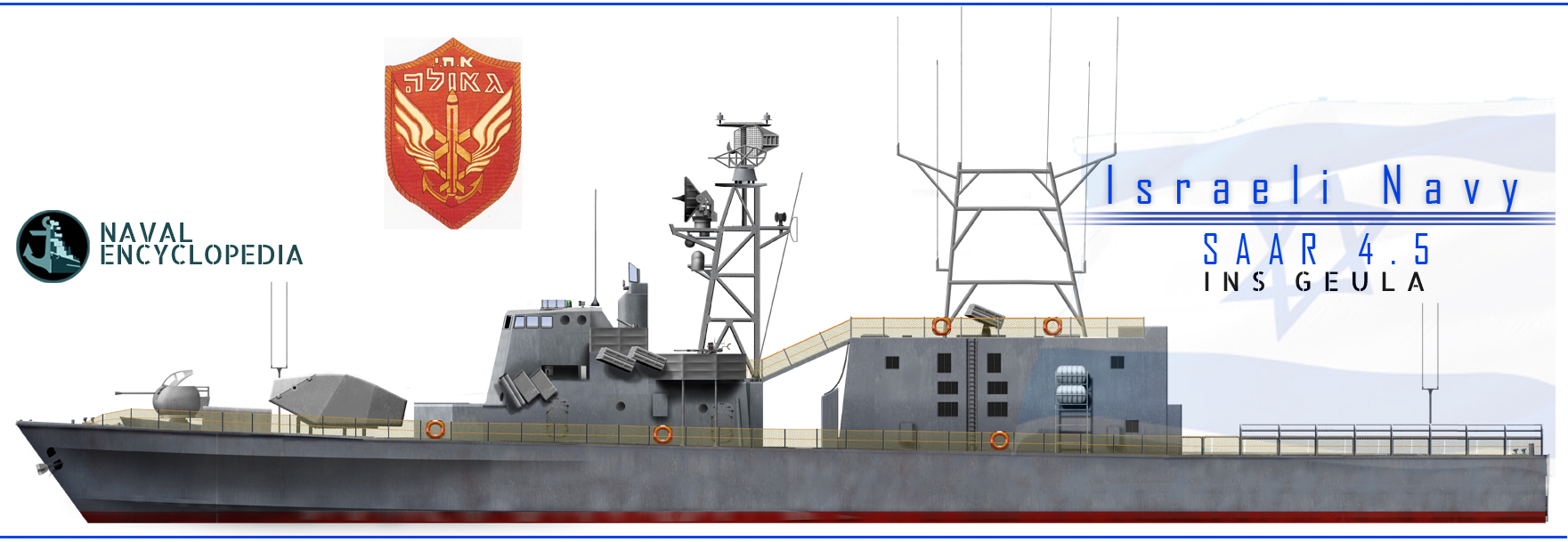
Profile of the SAAR 4.5 by the author, for Efim Sandler’s book, Helion Publishing
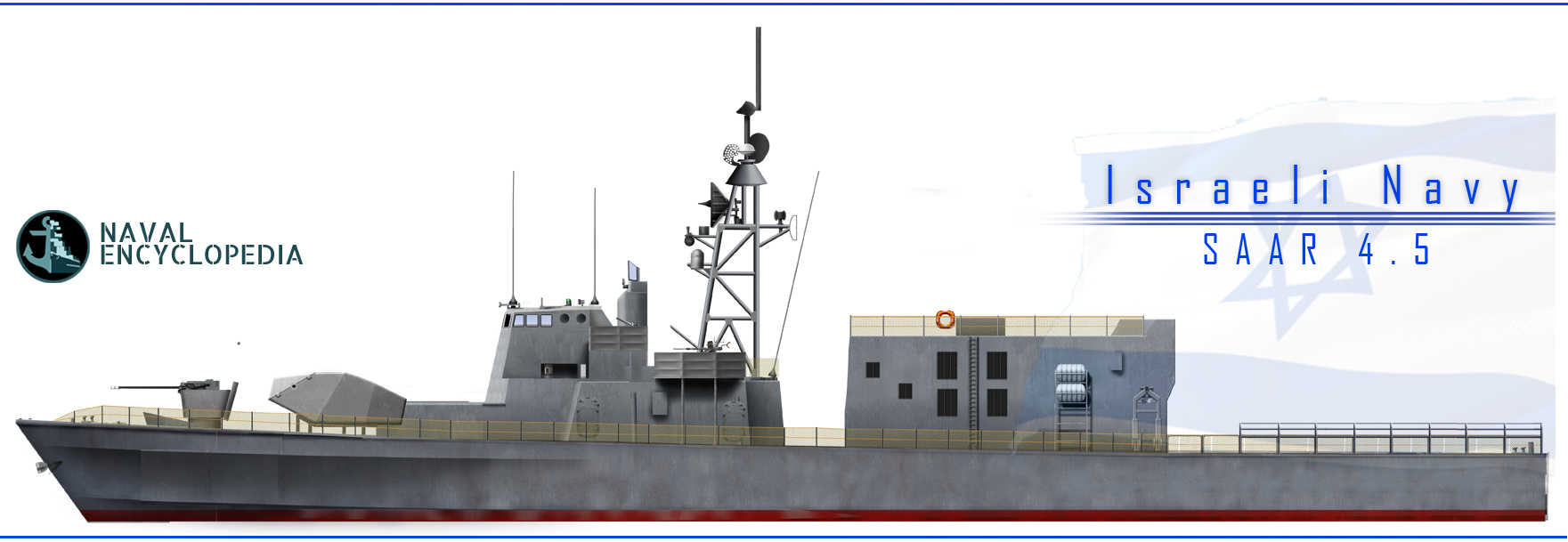
SAAR 4.5 Gueula by the author, for Efim Sandler’s book, Helion Publishing
The Sa’ar 4.5-class were Israeli Sea Corps missile boats designed and built by Israel Shipyards Ltd. They were imprpved and stretched Sa’ar 4-class missile boats and in time, two different subclasses were called Chochit then Aliya with two in class: INS Aliya and INS Geula, both helicopter-equipped boats. Launched 1980.
The second subclass was initially called Nirit and later Hetz (INS Romat, Keshet, Nirit). Launched 1981 but completed 1990, others 1982 and 1990, commissioned 1991.
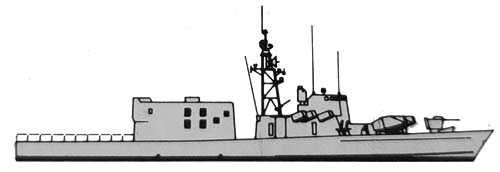
Specs (Aliya sub class):
Displacement: 430 tonnes standard, 498 tonnes full load
Dimensions: 61.7 x 7.62 x 2.8m (202 ft 5 in x 25 ft x 9 ft 2 in)
Propulsion: 4 MTU 16V956 TB91 V16 diesel engines 4,000 hp (3,000 kW) each
Speed: Cruiser 19 knots top 33 knots (61 km/h; 38 mph)
Range: 4,800 nm (8,900 km) at 19 knots, 2,200 nm (4,100 km) 30 knots
Complement: 53 officers and raitngs
Sensors: Thales Neptune AS search radar, Selenia Orion FCR, Elbit chaff RL, Elisra NS-9003A/9005 RWR
Armament: 4 Harpoon, 4 Gabriel, 2 Oerlikon 20 mm, Phalanx CIWS, 2x M2 Browning HMG, Eurocopter Panther Helicopter
SAAR 5 class missile corvettes (1982)

Conway’s rendition
A British source in 1982 stated that two ships of the “SAAR 5” type were in construction in France, and up to six more on order. The French reported this was a project offered by the yard, considered, but not ordered by the Israeli Navy. Internally known in CMN Cherbourg as “QU-09-35” and “Q9-Q35”, it was called by its trade name “Corvette 850”. It was proposed as an interim design from the last SAAR 4.5 (Reshef) 500 tons missile boats combining their high speed capabilities and agility to corvette-sized vessels with helicopter capabilities and better range. This was also reflected in a 1000-ton equivalent for electronics and armament, CIC.
They were intended for over the horizon target data acquisition for Harpoon FACs, with extensive command and control facilities, so acting a bit like “flotilla leaders” for SAAR 4/4.5 FACs. Tests were made for a low-mounted helicopter platform on INS Tarshish proved unsatisfactory, so the corvette size vessel was a better proposition. Planned armament in 1982 was conjectural, two quad canisters of Harpoon SSMs, two twin 30 mm Emerlec CIWS, a short range SAM, single or twin 40 mm/70 Breda oe 57 mm/70 Bofors, no TT. See the specs for the final, best known projected design. Eelctronics combined long range search/surveillance radars, air search, surface search, satnav, fire control, active/passive sonar and ECM. The project went nowhere and eventually evolved into a later German proposition of a stealthy ship proposed in 1988 and ordered in 1989, the Eilat class (SAAR 5).
 Shimrit class Hydropters FAC(M)s (1982)
Shimrit class Hydropters FAC(M)s (1982)
Shimrit, Linvit, Sampirit
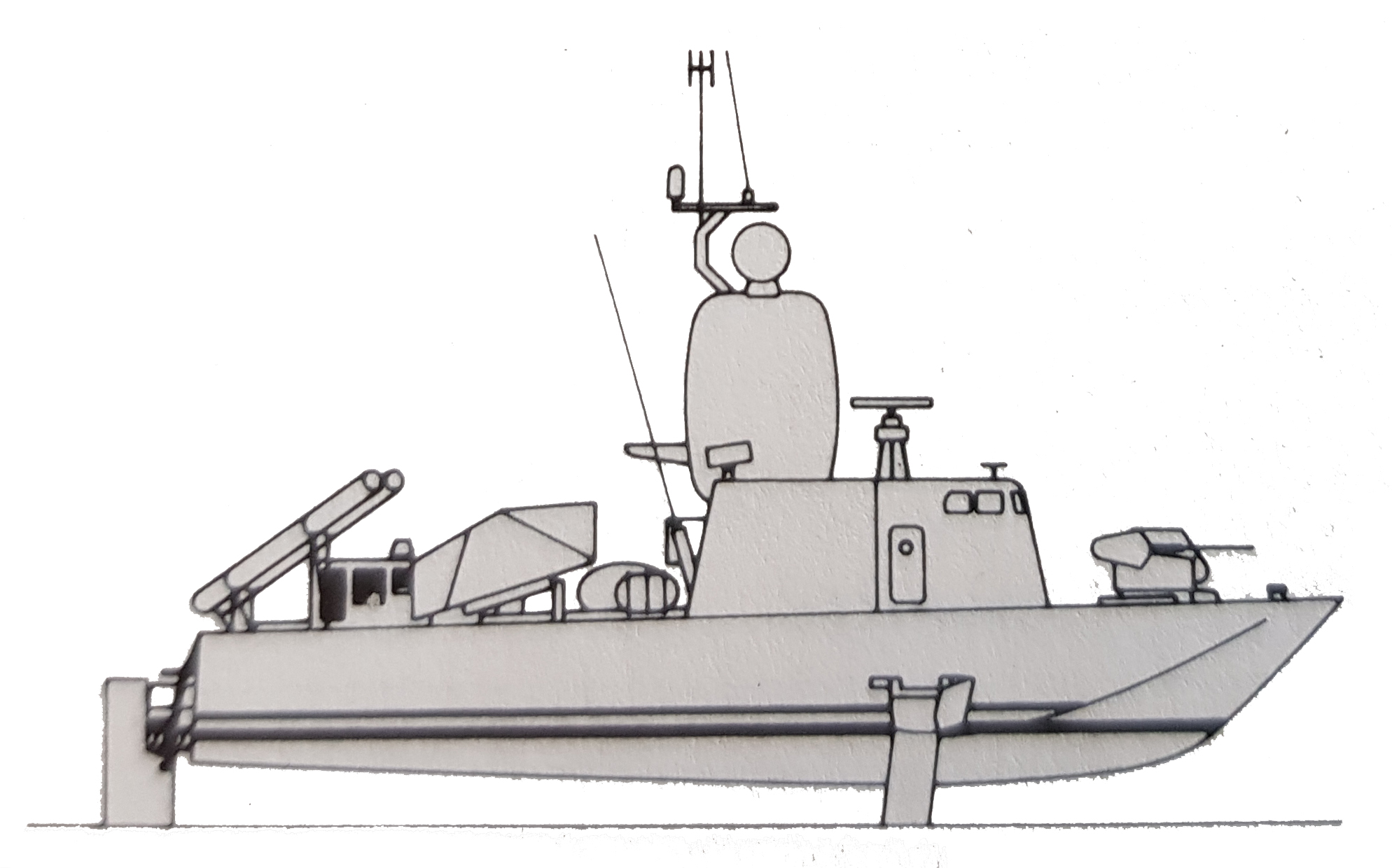
(Color HD profile to come)
USS Flagstaff (PGH-1) was the only patrol gunboat hydrofoil acquired by the United States Navy, tested for possible adoption because of her relatively low cost, very high speed, but ultimately this went nowhere due to budget cuts and she was loaned to the USCG. Nevertheless, the Grumman Lantana yard was approached by the IDF for the construcition of three of these, under the class named Shimrit (Guardian). Initial plans were to built 12 of these in Israel, however only two (Linvit, Sampirit) were. The program was terminated after encountering many delays. Indeed, the lead vessel developed such many teething problems and further troubles eventually were ironed out, but still on trials they never approached their design speed of 52 knots, rather 47 knots at best. Turning radius was also a disappointment, 200 m at 45 knots. Endurance was 5 days and they were of aluminium construction with pineapple shaped radome cocleas radar, fire control and contermeasure aerials.
They were all laid up and discarded in 1993.
Specs:
Displacement: 71t standard, 103-105t FL
Dimensions: 31.79 x 12.95 x 7.3 m height foils deployed
Machinery: 1s haft CP main prop, Allison 501KG GT, 5400 shp, 2 GM 6V53 auxiliary diesels for hydraulic foil
Range: 750 nm/72 kts, 2600 nm/8 kts
Armament: 2×2 Harpoon SSM, 2×1 Gabriel Mk.3 SSM, 2x 30mm Oerlikon TCM30, 2x 0.5 Browning M2HB
 Dvora class FPBs (1985)
Dvora class FPBs (1985)

These fast patrol boat built by Israel Aerospace Industries for the Israeli Sea Corps were based on the Israeli Dabur class. Nine are still in service since 1988, and they were also exported to Sri Lanka, ROCA, Gambia and Paraguay. More details in a dedicated article.
Specs:
Displacement: 45 tons full load
Displacement: 21.80 x 5.50 x 1.1 (71.5 x 18 x 3.6 ft)
Propulsion: 2× diesel 4,570 hp (3,410 kW), 2x Arneson ASD-16 art. surf. drives.
Speed: 37 knots (69 km/h; 43 mph)
Range: 560 nmi (1,040 km; 640 mi)
Armament: 1 × Oerlikon 20 mm, 2 × 0.5 in cal. M2HB
 Super Dvora class FPBs (1988)
Super Dvora class FPBs (1988)

The Dvora Mark II-class, called soon “super dvora” were follow-up high-speed patrol boats for off-shore coastal patrols and littoral warfare, also built by Israel Aerospace Industries for the Israeli Sea Corps. They saw action notably with the Sri Lanka Navy to counter LTTE operations.
Marine aluminum alloy planing hull, Oerlikon 20 mm cannon, manually operated. at first and later the IDF built Typhoon 25-30 mm RWS slaved to a mast-mounted electro-optic system. Heavy or light machine guns on pintles wherever needed.
The super dvora (23 built so far) are operated by IDF (2) and exported to Sri Lanka, Erithrea, India, and Slovenia.
Specs:
Displacement: 60 tons full load
Dimensions: 25.4 x 5.67 x 1.1m (83 x 18.6 x 3.6 ft)
Propulsion: 2x diesels 4,570 hp (3,410 kW), 2x Arneson ASD-16 ASD.
Speed: 45–52 knots (83–96 km/h)
Range: 700 nautical miles (1,300 km)/42 knots (78 km/h)
Armament: 1× Typhoon 25-30 mm RWS, 2 × 12.7 mm M2HB
 Shaldag class FAC(G)s (1989)
Shaldag class FAC(G)s (1989)
profile to come
The Shaldag-class patrol boat (“Kingfisher”) are small, fast patrol boats developed for the Israeli Navy, launched in 1989 after the experience of Lebanon, and since in service with IDF but also largely exported. It was designed for the same security tasks as the previous PBRs, but to intercept the new speedboats fielded by Lebanon militias, for interdiction of terrorism and illegal smuggling. It had better high speed in rough seas, excellent seakeeping, outstanding maneuverability, and exceptionally low slamming in all sea states with dry decks at all speeds.
So far, It had been declined in five variants tailored for th customer’s needs in vaious configurations of islands, sensors and armaments. Israel deployed five boats as of today, replacing the older Dabur class.
Specs:
Displacement: 72 tons
Dimensions: 24.8 x6 x 1.2 m (81 ft 4 in x 19 ft 8 in x 3 ft 11 in)
Propulsion: 2× MTU 12V 396 TE engines, 2× steerable KaMeWa water jets
Speed: 50 knots (93 km/h; 58 mph)
Capacity: 6 tons
Complement: 15
Armament: 1× Typhoon RWS 25 mm, 1x Oerlikon 20 mm, 2× 0.5 in HMG, Depth charges
Auxiliaries

Profile of INS Maoz by the author, for Efim Sandler’s book, Helion Publishing






 Latest Facebook Entry -
Latest Facebook Entry -  X(Tweeter) Naval Encyclopedia's deck archive
X(Tweeter) Naval Encyclopedia's deck archive Instagram (@navalencyc)
Instagram (@navalencyc)





 French Navy
French Navy Royal Navy
Royal Navy Russian Navy
Russian Navy Armada Espanola
Armada Espanola Austrian Navy
Austrian Navy K.u.K. Kriegsmarine
K.u.K. Kriegsmarine Dansk Marine
Dansk Marine Nautiko Hellenon
Nautiko Hellenon Koninklije Marine 1870
Koninklije Marine 1870 Marinha do Brasil
Marinha do Brasil Osmanlı Donanması
Osmanlı Donanması Marina Do Peru
Marina Do Peru Marinha do Portugal
Marinha do Portugal Regia Marina 1870
Regia Marina 1870 Nihhon Kaigun 1870
Nihhon Kaigun 1870 Preußische Marine 1870
Preußische Marine 1870 Russkiy Flot 1870
Russkiy Flot 1870 Svenska marinen
Svenska marinen Søværnet
Søværnet Union Navy
Union Navy Confederate Navy
Confederate Navy Armada de Argentina
Armada de Argentina Imperial Chinese Navy
Imperial Chinese Navy Marinha do Portugal
Marinha do Portugal Mexico
Mexico Kaiserliche Marine
Kaiserliche Marine 1898 US Navy
1898 US Navy Sovietskiy Flot
Sovietskiy Flot Royal Canadian Navy
Royal Canadian Navy Royal Australian Navy
Royal Australian Navy RNZN Fleet
RNZN Fleet Chinese Navy 1937
Chinese Navy 1937 Kriegsmarine
Kriegsmarine Chilean Navy
Chilean Navy Danish Navy
Danish Navy Finnish Navy
Finnish Navy Hellenic Navy
Hellenic Navy Polish Navy
Polish Navy Romanian Navy
Romanian Navy Turkish Navy
Turkish Navy Royal Yugoslav Navy
Royal Yugoslav Navy Royal Thai Navy
Royal Thai Navy Minor Navies
Minor Navies Albania
Albania Austria
Austria Belgium
Belgium Columbia
Columbia Costa Rica
Costa Rica Cuba
Cuba Czechoslovakia
Czechoslovakia Dominican Republic
Dominican Republic Haiti
Haiti Hungary
Hungary Honduras
Honduras Estonia
Estonia Iceland
Iceland Eire
Eire Equador
Equador Iran
Iran Iraq
Iraq Latvia
Latvia Liberia
Liberia Lithuania
Lithuania Mandchukuo
Mandchukuo Morocco
Morocco Nicaragua
Nicaragua Persia
Persia San Salvador
San Salvador Sarawak
Sarawak Uruguay
Uruguay Venezuela
Venezuela Zanzibar
Zanzibar Warsaw Pact Navies
Warsaw Pact Navies Bulgaria
Bulgaria Hungary
Hungary

 Bundesmarine
Bundesmarine Dutch Navy
Dutch Navy Hellenic Navy
Hellenic Navy Marina Militare
Marina Militare Yugoslav Navy
Yugoslav Navy Chinese Navy
Chinese Navy Indian Navy
Indian Navy Indonesian Navy
Indonesian Navy JMSDF
JMSDF North Korean Navy
North Korean Navy Pakistani Navy
Pakistani Navy Philippines Navy
Philippines Navy ROKN
ROKN Rep. of Singapore Navy
Rep. of Singapore Navy Taiwanese Navy
Taiwanese Navy IDF Navy
IDF Navy Saudi Navy
Saudi Navy Royal New Zealand Navy
Royal New Zealand Navy Egyptian Navy
Egyptian Navy South African Navy
South African Navy






























 Ukrainian Navy
Ukrainian Navy dbodesign
dbodesign